Axiom (Commercial Destination Module for International Space Station)
Technology Development
Axiom Commercial Destination Module for International Space Station
In January 2020, NASA selected Axiom Space of Houston to provide at least one habitable commercial module to be attached to the International Space Station as the agency continues to open the station for commercial use. 1)
“NASA has once again recognized the hard work, talent, and experience of Houstonians as we expand the International Space Station and promote commercial opportunities in space,” said Sen. John Cornyn of Texas. “I’m proud Axiom will continue to build upon Texas’ legacy of leading the nation in human space exploration.”
This selection is a significant step toward enabling the development of independent commercial destinations that meet NASA’s long-terms needs in low-Earth orbit, beyond the life of the space station, and continue to foster the growth of a robust low-Earth orbit economy.
"Today’s announcement is an exciting and welcome step forward in the efforts to commercialize low-Earth orbit,” said Sen. Ted Cruz of Texas. “This partnership between NASA and Axiom Space – a Houston, Texas original – illustrates how critically important the International Space Station is, and will continue to be, for developing new technologies for low-Earth orbit and beyond, and for continuing America’s leadership in space. Congratulations to Axiom Space on this exciting award – Houston is known as Space City for a reason, and I look forward to this great Space City company and NASA turning this announcement into reality."
The element will attach to the space station’s Node 2 forward port to demonstrate its ability to provide products and services and begin the transition to a sustainable low-Earth orbit economy in which NASA is one of many customers. NASA and Axiom next will begin negotiations on the terms and price of a firm-fixed-price contract with a five-year base performance period and a two-year option.
“Congratulations to Axiom Space! This is not only a win for Texas, Johnson Space Center, and the International Space Station, it is also a great step forward for NASA as we move towards an increased commercial presence in low-Earth orbit,” said Rep. Brian Babin of Texas. “I am proud to see this work coming to Space City – Houston, Texas – as the Lone Star State continues to lead in space exploration well into the future.”
Developing commercial destinations in low-Earth orbit is one of five elements of NASA’s plan to open the International Space Station to new commercial and marketing opportunities. The other elements of the five-point plan include efforts to make station and crew resources available for commercial use through a new commercial use and pricing policy; enable private astronaut missions to the station; seek out and pursue opportunities to stimulate long-term, sustainable demand for these services; and quantify NASA’s long-term demand for activities in low-Earth orbit.
“Axiom’s work to develop a commercial destination in space is a critical step for NASA to meet its long-term needs for astronaut training, scientific research, and technology demonstrations in low-Earth orbit,” said NASA Administrator Jim Bridenstine. “We are transforming the way NASA works with industry to benefit the global economy and advance space exploration. It is a similar partnership that this year will return the capability of American astronauts to launch to the space station on American rockets from American soil.”
NASA selected Axiom from proposals submitted in response to a solicitation through Appendix I of NASA’s Next Space Technologies for Exploration Partnerships (NextSTEP) 2 Broad Agency Announcement, which offered private industry use of the station utilities and a port to attach one or more commercial elements to the orbiting laboratory.
Because commercial destinations are considered a key element of a robust economy in low-Earth orbit, NASA also plans to issue a final opportunity to partner with the agency in the development of a free-flying, independent commercial destination. Through these combined efforts to develop commercial destinations, NASA is set to meet its long-term needs in low-Earth orbit well beyond the life of the station.
The agency will continue to need low-Earth orbit microgravity research and testing to enable future missions to the Moon and Mars, including the arrival of the first woman and next man on the Moon with the Artemis III mission as part of the agency’s Artemis lunar exploration plans.
On Feb. 28, 2020, NASA awarded Axiom a firm-fixed price, indefinite-delivery, indefinite-quantity contract with a maximum potential value, inclusive of options, of $140 million over an up to seven-year ordering period consisting of a five-year base period and a two-year option.
Axiom Station
The privately-owned platform that builds on the legacy and foundation of continuous human presence in Low Earth Orbit established by the ISS. The first elements of Axiom will attach to the forward node of the ISS, providing modern accommodations for more astronauts, a first-of-its-kind immersive view of our beautiful Earth, and additional research and manufacturing volume. 2)
When ISS is retired, Axiom Station will complete construction and detach to operate into the future as a free-flying complex for living and working in space – marking humankind’s next stage of LEO settlement.

The Axiom Segment will allow the company to support a wide range of commercial ventures, including space tourism, technology demonstrations, and on-orbit manufacturing. Axiom has already signed a deal with SpaceX for at least one commercial Crew Dragon flight, which will ferry one astronaut and three commercial spaceflight participants to the ISS for an eight to ten day flight sometime in 2021.
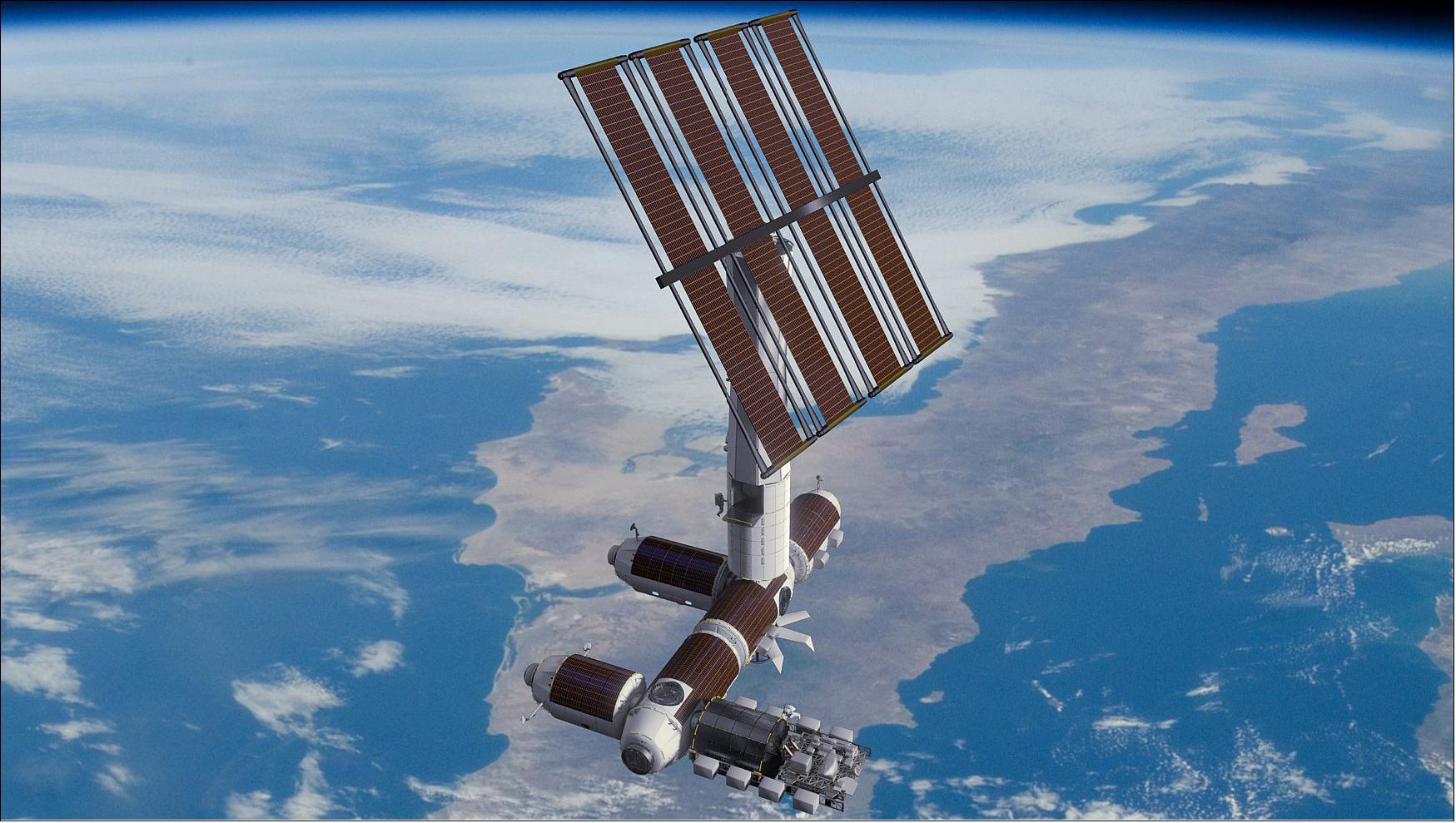
Background
NASA announced on 27 January 2020, that Houston-based Axiom Space will win access to a docking port on the station, to which the company will install a commercial module for research and other applications. The agency said that it will begin negotiations on a formal contract with Axiom, with a five-year base period and a two-year option. 3)
Axiom was founded in 2016 by Kam Ghaffarian, who previously led space industry engineering services company Stinger Ghaffarian Technologies, and Michael Suffredini, who was program manager for the ISS at NASA for a decade prior to his retirement from the agency in 2015. The company has several former astronauts in leadership positions, including former NASA administrator Charles Bolden, listed as a “business development consultant” on the company’s website.
Axiom says it believes that experience, as well as an industry team that includes Boeing, Thales Alenia Space Italy, Intuitive Machines and Maxar Technologies, played a key role in its selection. “There is a fantastically steep learning curve to human spaceflight,” Suffredini, president and chief executive of Axiom, said in a company statement. “The collective experience at Axiom is quite far along it. Because we know firsthand what works and what doesn’t in LEO, we are innovating in terms of design, engineering and process while maintaining safety and dramatically lowering costs.”
The company has revealed few technical details about its proposed addition to the ISS, other than that the “Axiom Segment” will ultimately include a node module, research and manufacturing facility, crew habitat and “large-windowed” module for viewing the Earth. Axiom expects the first module to be launched in the second half of 2024.
NASA did not disclose in its statement why it selected Axiom for the module. The agency’s statement did feature laudatory comments from Texas’ two senators, John Cornyn and Ted Cruz, as well as Rep. Brian Babin, whose district includes Axiom’s headquarters near the Johnson Space Center.
“This partnership between NASA and Axiom Space — a Houston, Texas original — illustrates how critically important the International Space Station is, and will continue to be, for developing new technologies for low Earth orbit and beyond, and for continuing America’s leadership in space,” Cruz said in the statement.
NASA had been studying making the docking port, on the station’s Node 2 or Harmony module, available to a commercial module for several years, issuing a request for information from industry on the topic in 2016. The effort got new life last June when the agency rolled out its low Earth orbit commercialization initiative, which offered the docking port through its Next Space Technologies for Exploration Partnerships (NextSTEP) program.
“Axiom’s work to develop a commercial destination in space is a critical step for NASA to meet its long-term needs for astronaut training, scientific research, and technology demonstrations in low Earth orbit,” NASA Administrator Jim Bridenstine said in an agency statement.
That statement added that a separate effort under NextSTEP to support development of a free-flying commercial space station will go forward. NASA issued a draft solicitation for that in October, but did not set a date for when the final solicitation will be released.
That’s welcome news for another company developing commercial space stations. “Congrats to @Axiom_Space on attached to space station commercial module selection!” tweeted Jeffrey Manber, chief executive of NanoRacks, after the NASA announcement. “Eager to see NASA offering on free flyer which is overdue.”
Another company long thought to be interested in adding a commercial module to the ISS is Bigelow Aerospace, who already has a small experimental module, called BEAM, attached to the station. A company official didn’t respond to a request for comment on Bigelow’s plans in the wake of the NASA award to Axiom.
Launch
The AX-1 commercial mission with a private crew of Axiom was launched on 8 April 2022 at 11:47 EST (15:47 UTC) from LC-39A at NASA/KSC (Kennedy Space Center), Cape Canaveral, Florida. A SpaceX Falcon 9 rocket propelled the Dragon Endeavour spacecraft carrying Ax-1 crew members Michael López-Alegría, Larry Connor, Mark Pathy, and Eytan Stibbe into orbit. 4)
“What a historic launch! Thank you to the dedicated teams at NASA who have worked tirelessly to make this mission a reality,” NASA Administrator Bill Nelson said. “NASA’s partnership with industry through the commercial cargo and crew programs has led our nation to this new era in human spaceflight — one with limitless potential. Congratulations to Axiom, SpaceX, and the Axiom-1 crew for making this first private mission to the International Space Station a reality.”
“I first want to congratulate Michael, Larry, Eytan, and Mark,” said Michael Suffredini, president and CEO of Axiom Space. “We will usher in a new era in private human spaceflight when they cross the threshold to enter the International Space Station. This journey is the culmination of long hours of training, planning, and dedication from the crew and the entire Axiom Space team, our partners at SpaceX, and of course, a credit to NASA’s vision to develop a sustainable presence in low-Earth orbit.”
Endeavour will autonomously dock to the space-facing port of the station’s Harmony module around 7:45 a.m. The welcome ceremony is expected to start shortly after the Dragon hatch opens at about 9:30 a.m. Saturday (9 April). Live mission coverage will end with the conclusion of the ceremony. The mission also will be covered by Axiom on its website.

The rocket’s first stage, on its fifth flight, landed on a droneship in the Atlantic Ocean. The stage previously launched SpaceX’s first non-NASA Crew Dragon mission, Inspiration4, last September, as well as two GPS missions and one set of Starlink satellites. 5)
Orbit: Near circular orbit, altitude of ~ 400 km, inclination = 51.6º.
Once aboard the station, the Axiom crew will be welcomed by Expedition 67 crew members, including NASA astronauts Thomas Marshburn, Raja Chari, and Kayla Barron, ESA (European Space Agency) astronaut Matthias Maurer, and Roscosmos cosmonauts Oleg Artemyev, Sergey Korsokov, and Denis Matveev.
Axiom Space astronauts are expected to spend about 10 days in orbit before a return to Earth and splashdown at one of seven landing sites off the coast of Florida. NASA and Axiom will release separate advisories to preview the Ax-1 farewell event and return coverage.
• April 9, 2022: Axiom Mission 1 (Ax-1) astronauts Michael Lopez-Alegria, Larry Connor, Eytan Stibbe, and Mark Pathy now are aboard the International Space Station following Crew Dragon’s hatch opening at 10:13 a.m. EDT, Saturday, April 9. 6)
- Ax-1 docked to the orbital complex at 8:29 a.m. while the spacecraft were flying 260 miles above the central Atlantic Ocean. It is the first mission with an entirely private crew to arrive at the orbiting laboratory.
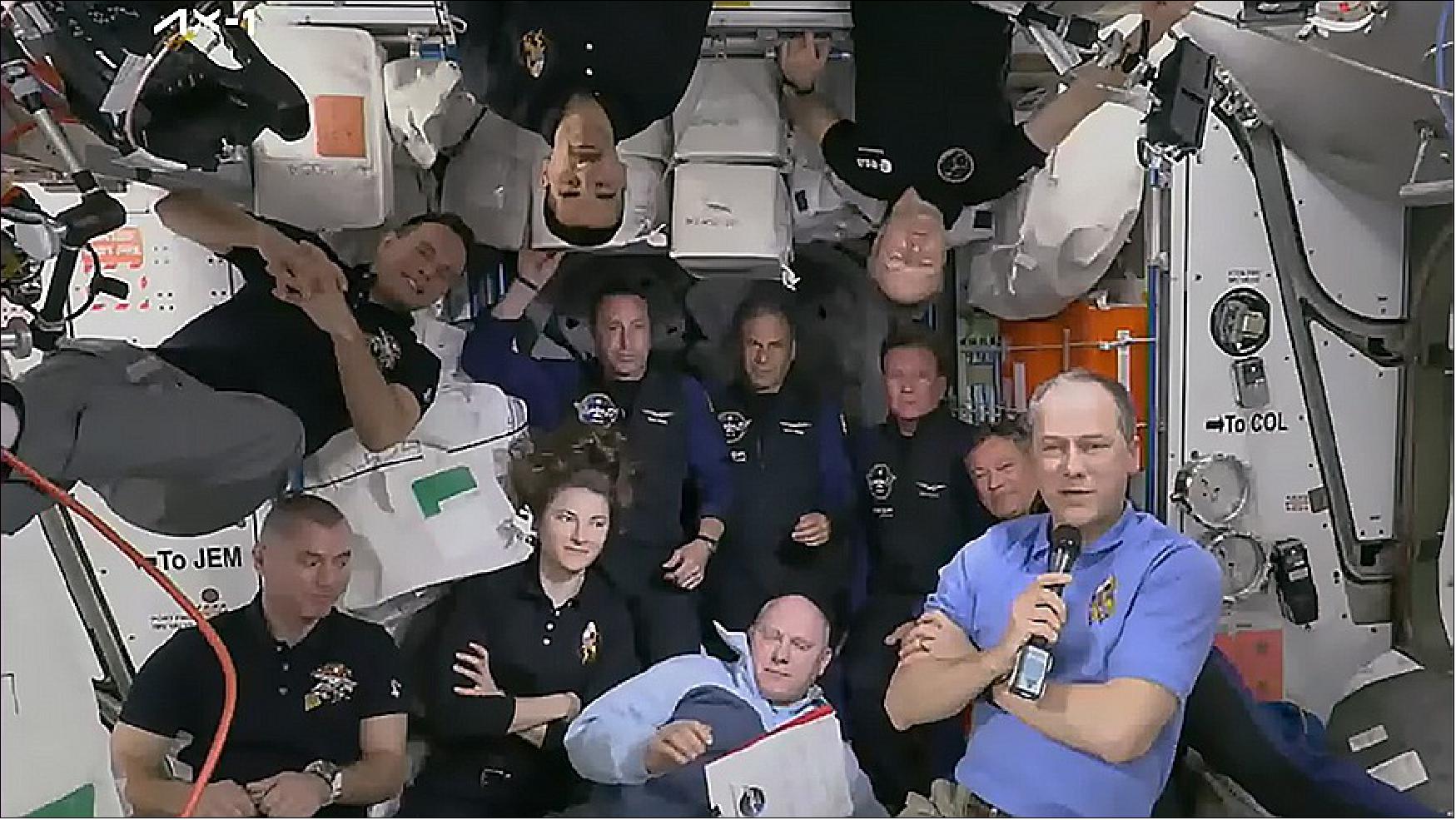
- The Axiom crew are joining Expedition 67 crew members, including NASA astronauts Marshburn, Raja Chari, and Kayla Barron, ESA (European Space Agency) astronaut Matthias Maurer, and Roscosmos cosmonauts Oleg Artemyev, Sergey Korsokov, and Denis Matveev.
• April 19, 2022: NASA, Axiom Space, and SpaceX waved off the undocking opportunity of Axiom Mission 1 from the International Space Station on Tuesday, April 19 due to unfavorable weather conditions for return. The integrated NASA, Axiom Space, and SpaceX teams are continuing to assess the next best opportunity for return of the first private astronaut mission to the orbiting laboratory based on weather conditions and space station operations. 7)
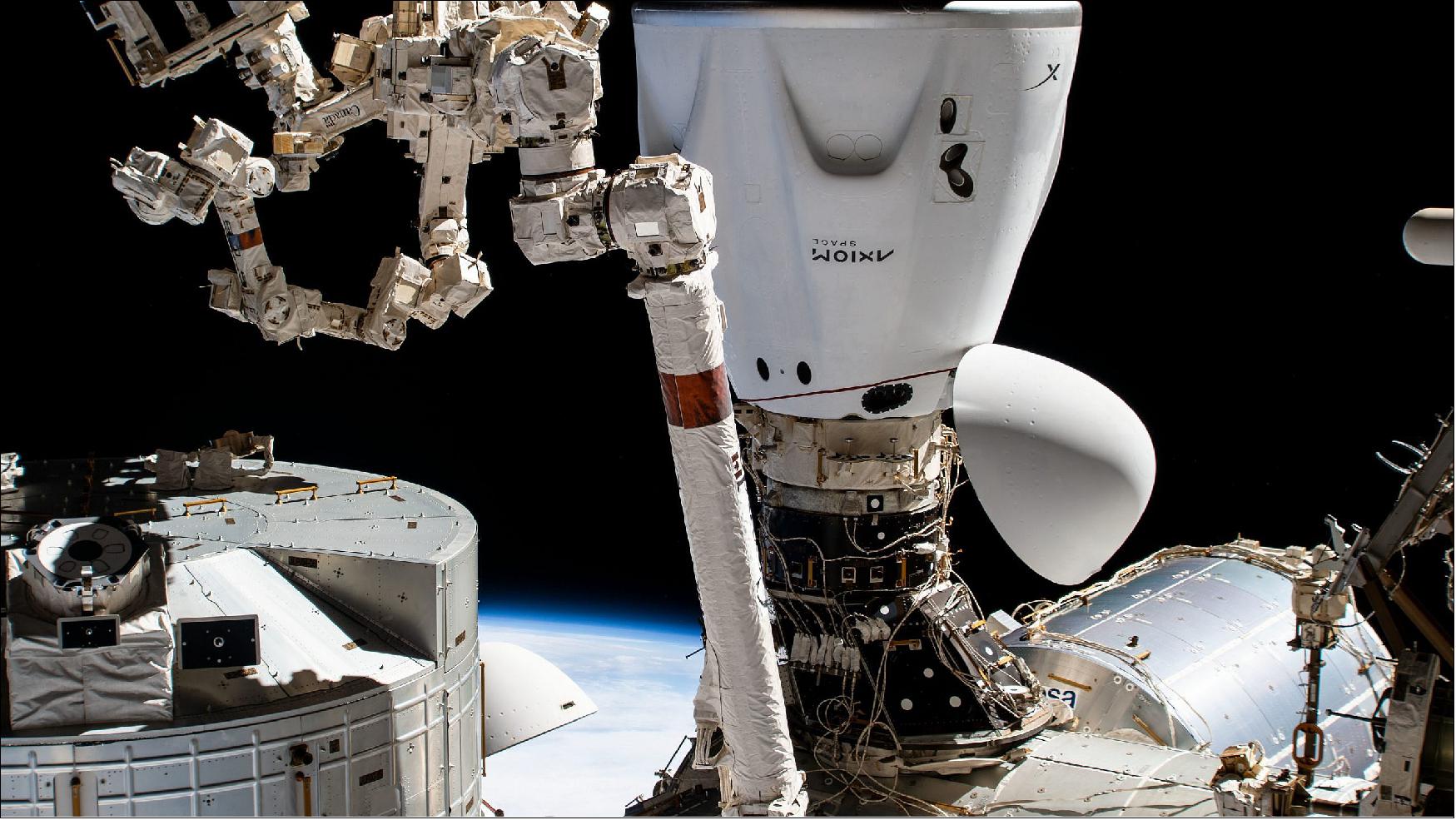
• April 20, 2022: Poor weather will delay the return to Earth of four private astronauts from the International Space Station, which could in turn push back the launch of the next set of NASA and ESA astronauts to the station. 8)
- The Crew Dragon spacecraft Endeavour was scheduled to undock from the ISS April 19, setting up a splashdown on the morning of April 20 off the Florida coast to conclude the Ax-1 mission to the station by Axiom Space. NASA announced April 18, though, that the undocking had been delayed to the evening of April 19, with splashdown moved to the afternoon of April 20.
- The spacecraft’s departure faces further delays. NASA said April 19 the agency, working with Axiom Space and SpaceX, postponed the Crew Dragon departure, again because of weather. The agency and companies “are continuing to assess the next best opportunity for return of the first private astronaut mission to the orbiting laboratory based on weather conditions and space station operations,” NASA said in a brief statement.
- Axiom Space suggested an extended delay in its own statement. “Due to unfavorable weather conditions for return, tonight’s undocking has been waved off and the crew will be spending a few more days on the space station,” the company said in an April 19 statement.
- Neither NASA nor Axiom Space have stated when they expect the next opportunity to return to Earth will be. Federal Aviation Administration notices to air missions, or NOTAMs, restrict airspace at several potential splashdown locations on both April 21 and 22.
- That delayed return could affect the launch of another Crew Dragon on NASA’s Crew-4 mission, currently scheduled for early April 23. NASA officials previously stated they want at least 48 hours between the Ax-1 splashdown and the Crew-4 launch to provide time for post-splashdown reviews of the Crew Dragon’s performance during reentry.

- “We’ll have time to do a review between that landing and the Crew-4 launch, and we’ll preserve 48 hours in between the landing event and the launch just to make sure the recovery team is ready for the launch and that we review all that data,” Steve Stich, NASA commercial crew program manager, said at an April 15 briefing.
- Despite its delayed departure, NASA and Axiom Space held a departure ceremony April 19 for the Ax-1 crew on the ISS. The four private astronauts — mission commander Michael López-Alegría and customers Larry Connor, Eytan Stibbe and Mark Pathy — arrived on the station April 9 for what was originally intended to be an eight-day stay.
- López-Alegría thanked the four NASA and ESA astronauts currently on the station for being “gracious and patient” with his private astronaut crew. “They’ve shared their time, their wisdom, their food, their stories,” he said. “Especially the first couple of days, we would not have gotten through without them bailing us out on more than one occasion.”
- “We hope to see a lot more PAM missions into the future,” Tom Marshburn, the NASA astronaut commanding the station, said, using NASA’s terminology for private astronaut missions (PAMs) like Ax-1. “We think we’ve accomplished a lot up here.”
• April 24, 2022: A Crew Dragon undocked from the International Space Station April 24 carrying four private astronauts who spent nearly twice as long on the station as originally planned. 9)
- The Crew Dragon spacecraft Endeavour undocked from the station at 9:10 p.m. EDT. The undocking sets up a splashdown off the Florida coast scheduled for 1:06 p.m. Eastern April 25. While SpaceX has several potential landing sites to choose from, NASA said the primary site is in the Atlantic Ocean offshore from Jacksonville.
- “Thanks once again for all of the support through this amazing adventure that we’ve had, even longer and more exciting than we thought,” Michael López-Alegría, commander of the Crew Dragon spacecraft, told space station controllers once the spacecraft departed the vicinity of the ISS shortly after undocking.
- The undocking marks the final phase of Axiom Space’s Ax-1 mission, which started with an April 8 launch on a Falcon 9 from the Kennedy Space Center. The mission, the first private astronaut mission by a U.S. spacecraft to the ISS, is commanded by López-Alegría, a former NASA astronaut, with three customers: Larry Connor, Eytan Stibbe and Mark Pathy.
- Endeavour docked to the ISS April 9 for what was originally billed as an eight-day stay. However, the spacecraft spent more than 15 days at the station, its departure delayed primarily by poor weather at splashdown locations. Neither NASA nor Axiom Space elaborated on the specific weather criteria, like winds or wave conditions, that prevented a splashdown, other than “marginally high winds” that delayed the undocking from April 23 to April 24.
- The extended stay did not materially affect station operations. “NASA and Axiom mission planning prepared for the possibility of additional time on station for the private astronauts, and there are sufficient provisions for all 11 crew members aboard the space station,” the agency said in an April 20 blog post.
- It did raise questions, though, about whether it would cost Axiom and its private astronaut customers more money. “The agreement between NASA and Axiom allowed for the possibility of extra days,” Axiom spokesperson Dakota Orlando told SpaceNews April 24, but did not answer questions about the details of that agreement.
- NASA spokesperson Stephanie Schierholz said April 24 that the agreement included an “equitable balance” to cover delays. “Knowing that International Space Station mission objectives like the recently conducted Russian spacewalk or weather challenges could result in a delayed undock, NASA negotiated the contract with a strategy that does not require reimbursement for additional undock delays,” she said.
- The additional time on the station didn’t go to waste. The four private astronauts had a “tightly packed research schedule,” Orlando said, at times working 14 hours a day. “With the delay, they have continued working on these research and outreach projects at a more leisurely pace, with additional time to enjoy views of the blue planet.”
- Before the launch, Axiom executives emphasized the research they would do over the sightseeing that the station would offer. “They’re not up there to place their noses on the window. They really are going up there to do meaningful research,” said Michael Suffredini, president and chief executive of Axiom Space, at a briefing about the mission in February.
- The undocking was not affected by an ISS maneuver April 23. The Progress MS-18 spacecraft docked to the station’s Russian segment fired its thrusters for 10 minutes and 23 seconds to increase the station’s orbit by about two kilometers. NASA advertised the maneuver as one that “optimizes phasing for future visiting vehicles arriving at the station,” but was originally described as one to avoid a piece of debris projected to come close to the station.
- NASA spokesperson Gary Jordan said that while flight controllers were tracking a potential conjunction, or close approach, of debris to the station, “the conjunction went green,” or no longer posed a threat. “Flight control teams elected to proceed with a nominal reboost,” he said.
- The debris in question, Jordan said, was an object with a NORAD ID of 51157, and is one of more than a thousand pieces of tracked debris created by Russia’s antisatellite weapon demonstration in November 2021 that destroyed a defunct Russian satellite, Cosmos 1408.
• April 25, 2022: A Crew Dragon spacecraft returned to Earth April 25, ending a 17-day mission that ferried four private astronauts to and from the International Space Station. 10)
- The Crew Dragon spacecraft Endeavour splashed down in the Atlantic Ocean off the coast from Jacksonville, Florida, at 1:06 p.m. EDT after a normal reentry. The spacecraft had undocked from the station 16 hours earlier.
- Unlike two previous Dragon splashdowns, where one of four main parachutes opened later than the other three, all four parachutes on this spacecraft opened at the same time. NASA and SpaceX had played down any concerns about the delayed parachute opening, saying it may be a normal aerodynamic phenomenon and did not pose a risk to the spacecraft or the people inside.
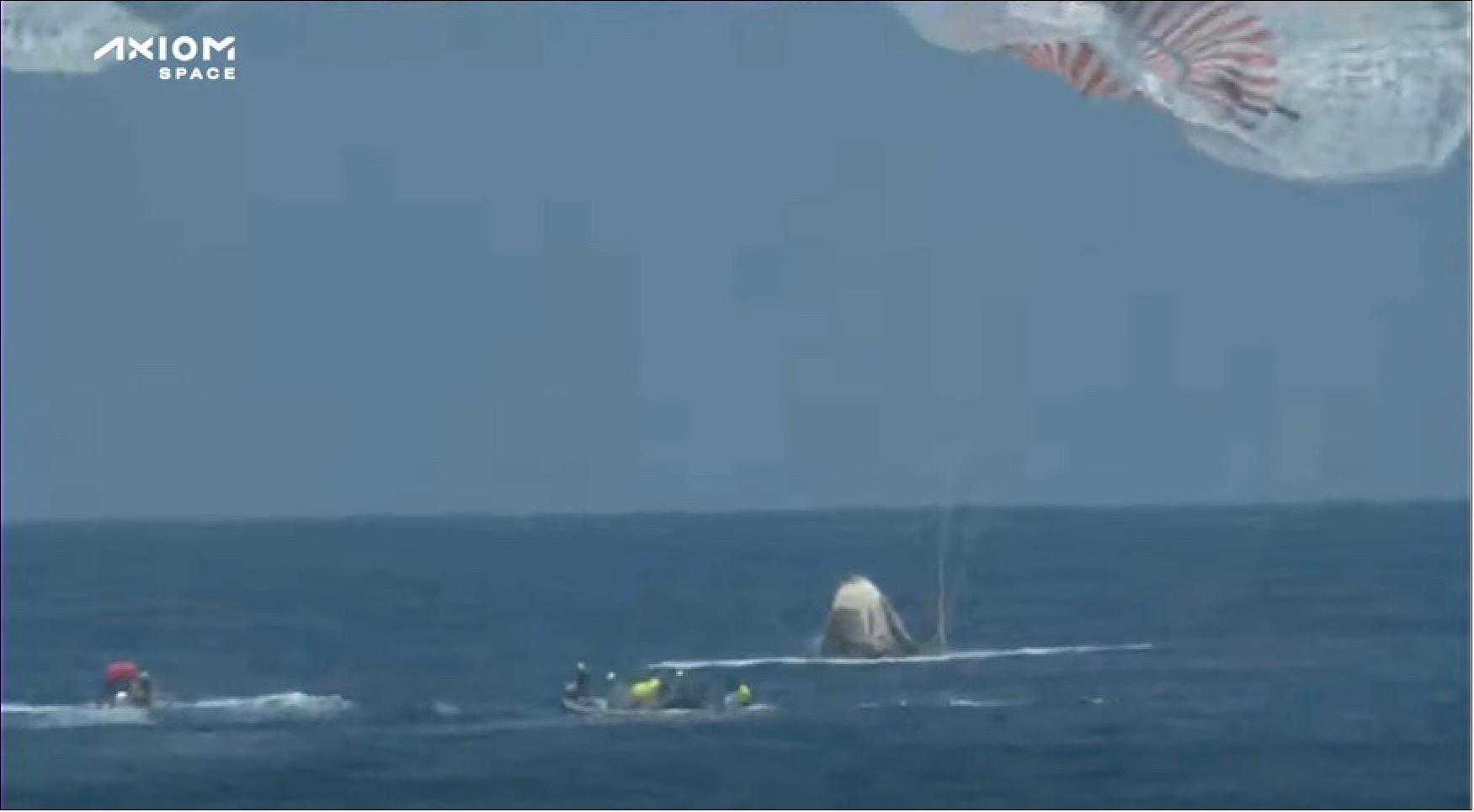
- Endeavour returned to Earth four private astronauts on Axiom Space’s Ax-1 mission. Michael López-Alegría, a former NASA astronaut, commanded the mission. One customer, Larry Connor, served as pilot, while two others, Eytan Stibbe and Mark Pathy, were mission specialists.
- The four launched April 8 and docked with the station less than 24 hours later for what was planned to be an eight-day stay. However, persistent bad weather at splashdown locations in the Atlantic Ocean and Gulf of Mexico kept Dragon in orbit for an extra week. NASA and Axiom Space said their agreement for the mission incorporated the possibility of such delays, so that Axiom Space was not charged extra for the additional time on the station.
- “Here we are at the conclusion of an incredible mission, and I must say the teams exceeded every expectation,” Amir Blachman, chief business officer of Axiom Space, said on the joint Axiom/SpaceX webcast after splashdown. “We could not be more proud of what has just been accomplished.”
- The departure and return of Ax-1 allows NASA to proceed with the launch of a new set of professional astronauts to the ISS. The Crew-4 mission is scheduled to launch on another Crew Dragon spacecraft, Freedom, April 27 at 3:52 a.m. EDT. It will deliver the Crew-4 astronauts of Kjell Lindgren, Bob Hines and Jessica Watson of NASA and Samantha Cristoforetti of the European Space Agency to the ISS.
- Approximately five days after the arrival of Crew-4, the Crew-3 astronauts of Raja Chari, Thomas Marshburn and Kayla Barron of NASA and Matthias Maurer of ESA will return to Earth on another Crew Dragon spacecraft, ending a mission that started with their launch to the station in November 2021.
Development Status
• June 1, 2022: NASA has selected Axiom Space and Collins Aerospace to advance spacewalking capabilities in low-Earth orbit and at the Moon, by buying services that provide astronauts with next generation spacesuit and spacewalk systems to work outside the International Space Station, explore the lunar surface on Artemis missions, and prepare for human missions to Mars. 11)
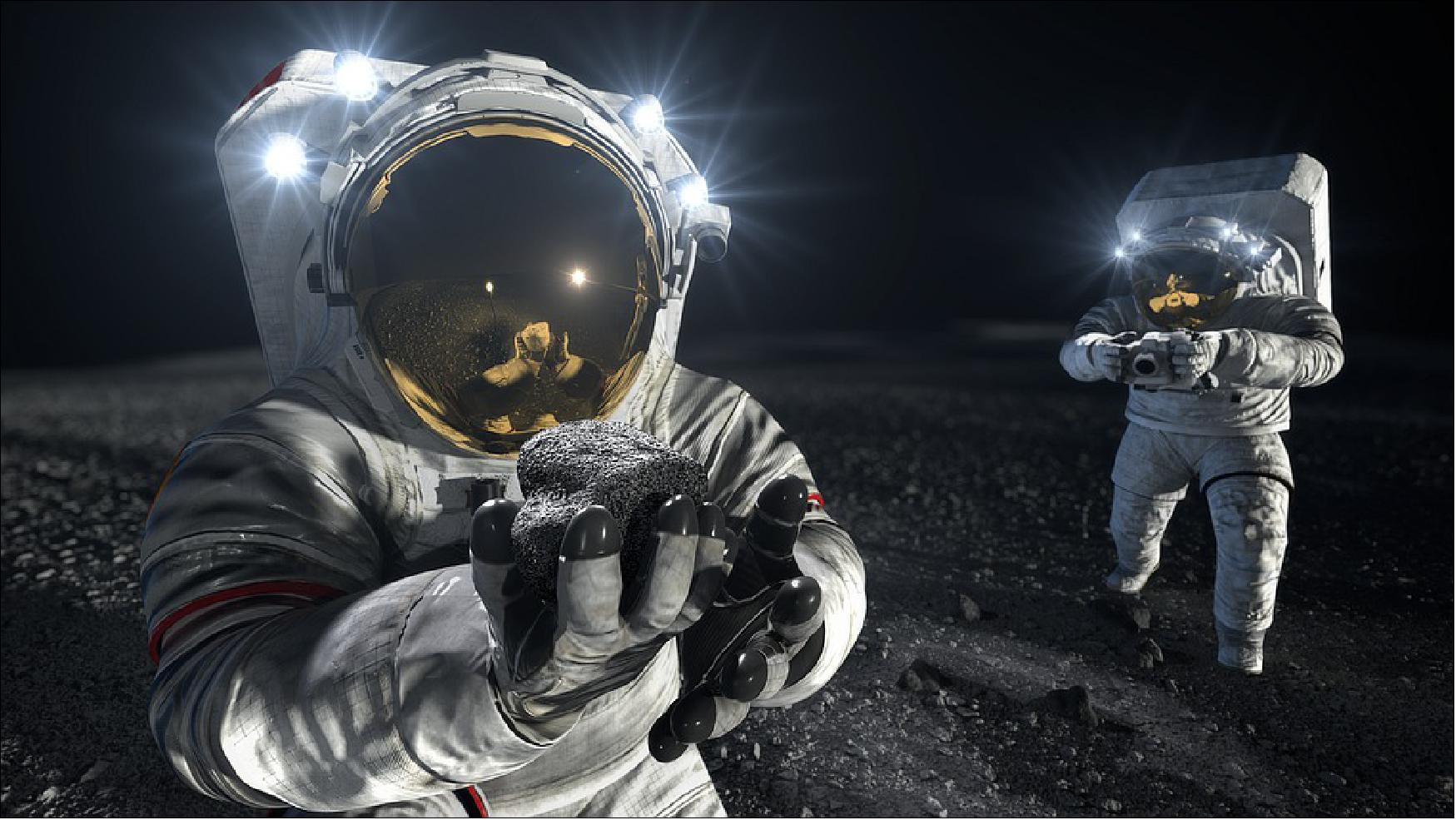
- The awards leverage NASA expertise with commercial innovation to support continued science at the orbiting laboratory and long-term human exploration at the Moon under Artemis, including landing the first woman and first person of color on the lunar surface.
- “With these awards, NASA and our partners will develop advanced, reliable spacesuits that allow humans to explore the cosmos unlike ever before,” said Vanessa Wyche, director of NASA’s Johnson Space Center in Houston. “By partnering with industry, we are efficiently advancing the necessary technology to keep Americans on a path of successful discovery on the International Space Station and as we set our sights on exploring the lunar surface.”
- The companies selected were chosen from the Exploration Extravehicular Activity Services (xEVAS) contract solicitation. The contract enables selected vendors to compete for task orders for missions that will provide a full suite of capabilities for NASA’s spacewalking needs during the period of performance through 2034. The indefinite delivery and indefinite quantity, milestone-based xEVAS contract has a combined maximum potential value of $3.5 billion for all task order awards. The first task orders to be competed under the contract will include the development and services for the first demonstration outside the space station in low-Earth orbit and for the Artemis III lunar landing.
- Each partner has invested a significant amount of its own money into development. Partners will own the spacesuits and are encouraged to explore other non-NASA commercial applications for data and technologies they co-develop with NASA. This new approach to spacewalk services encourages an emerging commercial market for a range of customers, and grants NASA the right to use the same data and technologies within the agency and on future exploration program procurements.
- NASA experts defined the technical and safety standards by which the spacesuits will be built, and the chosen companies agreed to meet these key agency requirements. The commercial partners will be responsible for design, development, qualification, certification, and production of spacesuits and support equipment to enable space station and Artemis missions.
- “Our commercial partnerships will help realize our human exploration goals,” said Mark Kirasich, deputy associate administrator of NASA’s Artemis Campaign Development Division. “We look forward to using these services for NASA’s continued presence in low-Earth orbit and our upcoming achievement of returning American astronauts to the Moon’s surface. We are confident our collaboration with industry and leveraging NASA’s expertise gained through over 60 years of space exploration will enable us to achieve these goals together.”
- The agency will continue to make flight- and ground-based test data from NASA-led space station spacewalks and NASA’s Exploration Extravehicular Mobility Unit (xEMU) development project available to companies through the EVA Technical Library. This will encourage an accelerated transition to industry while reducing risks and providing access to previous NASA investments in advanced exploration spacesuit development.
- NASA designed the contract to endure and evolve with needs of the agency and space industry. The contract also provides the agency with an optional mechanism to add additional vendors that were not selected in the original award announcement as the commercial space services market evolves.
- The xEVAS contract is managed by the EVA & Human Surface Mobility Program at NASA Johnson. NASA’s goal is to provide safe, reliable, and effective capabilities that allow astronauts to survive and work outside the confines of a spacecraft to maintain space station and explore the areas on and around the Moon.
• May 25, 2022: Axiom Space, a leader in human spaceflight currently building the world's first commercial space station, has signed a memorandum of understanding (MOU) with the Italian government to further their existing collaboration, including the potential for the development of space infrastructure integrated with the future Axiom Station. The agreement was signed by the President and CEO of Axiom Space, Michael Suffredini, and Italy's Minister for Technological Innovation and Digital Transition, Vittorio Colao, on 19 May in Rome, Italy. 12)
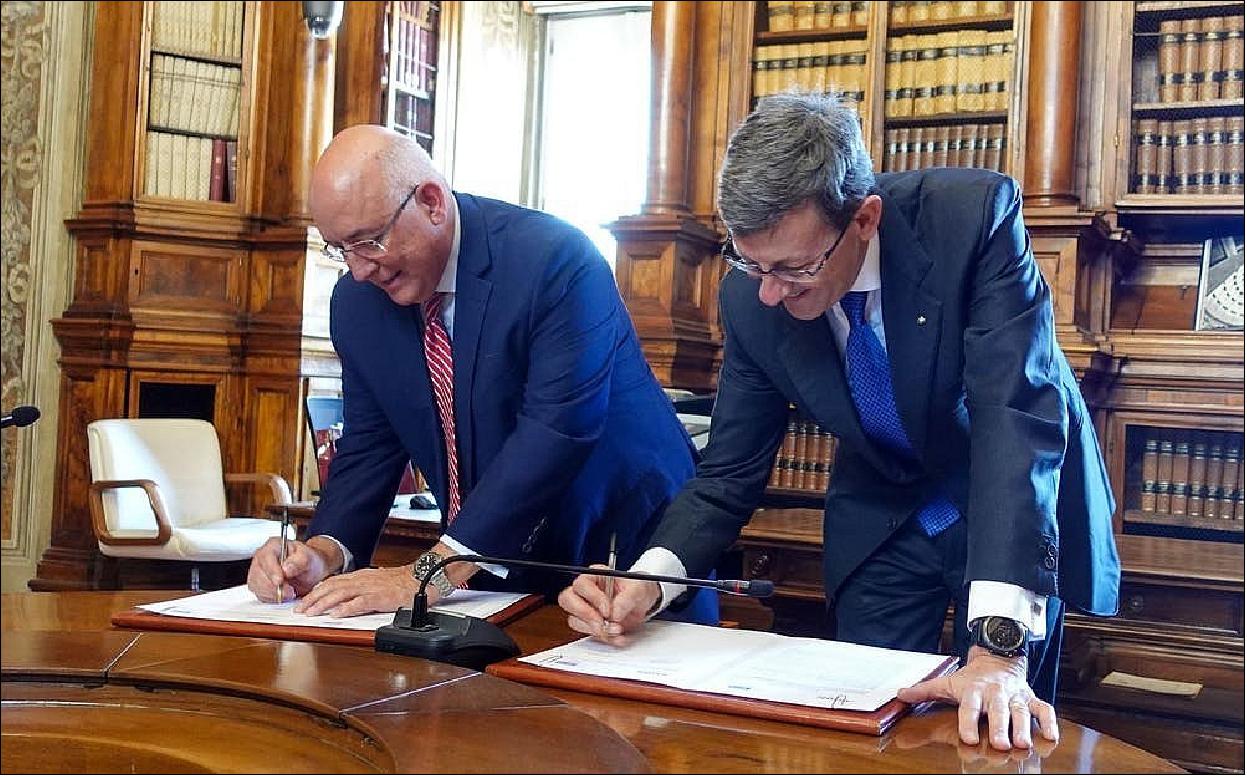
- While the MOU is exploratory in nature, areas of cooperation outlined in the agreement include mutual definition of potential user requirements as well as technological solutions and operational concepts for an Italian module that could later be developed and integrated into the Axiom Space Station. The project could take the form of a public-private framework with the governance and business models developed over time. Other areas of cooperation include collaborative development and implementation of research supporting space exploration and technology, including advanced materials, pharmaceuticals, on-orbit manufacturing, space security, aerospace medicine, simulation and robotics, and other areas of mutual interest as determined by the two parties, as well as training and mission operations.
- The MOU – a first-of-its-kind approach between the Italian government and a private international corporation - is the latest effort between Italy and the Houston-based Axiom Space. Earlier this year, Axiom announced Italian Air Force (ItAF) Colonel Walter Villadei as the company's first international professional astronaut. He is currently in training in Houston. Col. Villadei has been selected by Axiom as a backup on the Ax-2 mission, and an initial agreement has been signed for a reservation on a mission targeting late 2023. Based on ItAF's significant competencies in the field of astronautics, modeling and simulation, and aerospace medicine, such a mission will allow the implementation of multidisciplinary scientific and technological experiments from the Italian research and industrial community and will further strengthen the relationship being established under the MOU just signed.
- Together, these agreements between Axiom and Italy demonstrate the promise and viability of business to government (B2G) relationships that can help grow and expand the commercial space economy across multiple industries and market sectors. A Joint Working Group, composed of representatives from Axiom and institutions and industrial representatives appointed by the Italian Government, will pursue the implementation of the MOU.
- "As one of the first European countries invested in the International Space Station, this agreement with the Italian government will bring an experienced partner to Axiom Station, helping to open a new paradigm as we build this next generation microgravity platform in low Earth orbit", said Michael Suffredini. "The MOU is a significant addition to Axiom Space's long-standing relationship with Italy and reflects our shared commitment to expand global access to space and grow the LEO economy while advancing science and technology to benefit all of humanity."
- Axiom Station will provide the international community with a modern, efficient, and cost-effective space infrastructure that enables microgravity research, further technological developments, and operations to continue seamlessly after the ISS end of life. The collaboration between Axiom and Italy will harness microgravity for the development of advanced scientific research, innovative technologies, on-orbit manufacturing, and space exploration.
- "The agreement intends to deepen cooperation for the development and implementation of projects in the aerospace sector…[it represents] the enrichment of the excellent and historical bilateral relations between the United States and Italy, with cooperation also in the field of commercial space flight seen as an opportunity to develop a new chapter of the human presence around the Earth and on the Moon for the benefit of the whole humanity", according to a statement released by the Italian government.
- The agreement with Italy adds to Axiom Space's list of recent accomplishments in its efforts to grow the commercial space industry. Earlier this month, Axiom Space celebrated the groundbreaking at the company's new, long-term headquarters at Houston Spaceport, which will be home to the development and construction of Axiom Station. Axiom Space also recently welcomed home the Axiom Mission 1 (Ax-1) crew after successfully completing the first all-private astronaut mission to the ISS. The company has also signed agreements with several nations, including Hungary and the United Arab Emirates (UAE) to fly on future space missions.
• April 29, 2022: The exciting new era of commercial human spaceflight ushered in over the past three weeks by the successful Axiom Mission 1 (Ax-1), the first private mission to the International Space Station (ISS), entered a new phase with the signing of an agreement between Axiom Space and the Mohammed bin Rashid Space Center (MBRSC) of the United Arab Emirates (UAE) to fly a UAE professional crew member to the ISS on NASA's SpaceX Crew 6, expected to occur in 2023. 13)
- "It is our great pleasure to sign the agreement with the United Arab Emirates' Mohammed bin Rashid Space Center, marking the first time a commercial space company has made such a mission possible," said Michael Suffredini, President and CEO of Axiom Space. "Axiom Space is proud to provide MBRSC with a fight opportunity for a UAE astronaut, enabling its first long-term mission to the ISS."
- While UAE has previously flown an astronaut to the ISS onboard the Soyuz MS15 spacecraft, this will be the first non-ISS partner professional astronaut flight facilitated by a U.S. commercial space company. The mission is expected to last approximately six months, marking the first long-duration flight of an astronaut from an Arab nation. In yet another first, the UAE crew member will serve as a member of two Expedition crews onboard the space station across the roughly six-month interval.
- The flight opportunity provided by Axiom has its origins in a no-funds contract signed between NASA and Axiom to fly a NASA astronaut onboard a Soyuz seat, previously purchased by Axiom, in order to ensure continuous U.S. presence onboard the ISS. In exchange, NASA provided Axiom the right to use a seat owned by NASA onboard a commercial U.S. spacecraft traveling to the ISS in the future. Since the seats were deemed of equal value, there will be no future exchange of funds between NASA and Axiom for the flight opportunity. Axiom's agreement with MBRSC is between the company and the UAE space agency.
- The agreement was signed at the Embassy of the United Arab Emirates in Washington, D.C. on April 27 by Salem Humaid AlMarri, Director-General of MBRSC and Michael Suffredini, and announced by His Highness Sheikh Mohammed Bin Rashid Al Maktoum, Vice President and Prime Minister of the UAE and Ruler of Dubai.
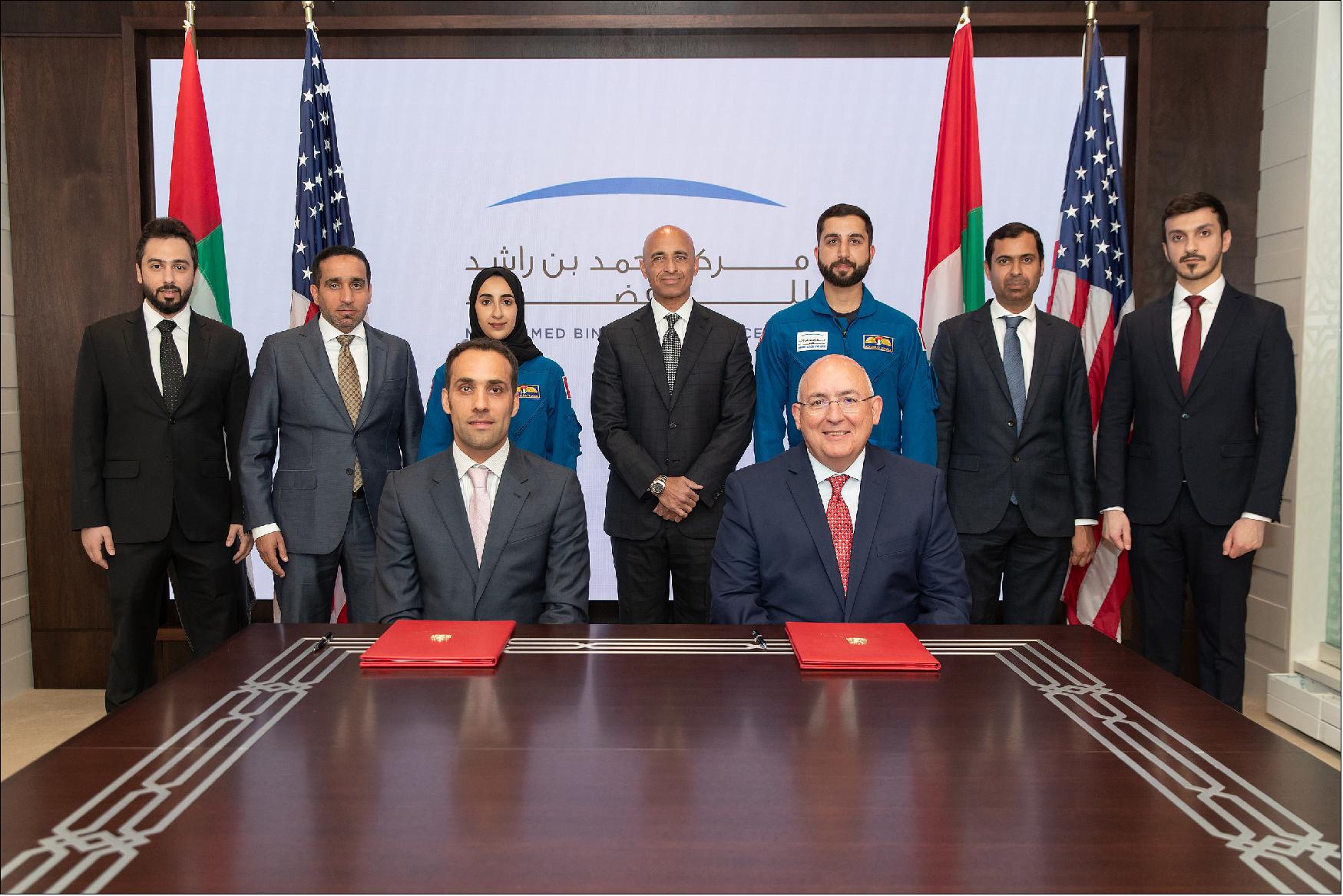
• February 2, 2022: NASA and its international partners approved crew members for Axiom Space’s first private astronaut mission to the International Space Station. The flight, called Axiom Mission 1 or Ax-1, is targeted to launch Wednesday, March 30, from Launch Complex 39A at NASA’s Kennedy Space Center in Florida on a flight-proven SpaceX Falcon 9 rocket. The Ax-1 crew will fly on Crew Dragon Endeavour to and from the space station. After 10 days in orbit, the Ax-1 crew will splash down off the coast of Florida. 15)
- Axiom Space astronauts Michael López-Alegría, Larry Connor, Mark Pathy, and Eytan Stibbe are prime crew members of the Ax-1 mission. López-Alegría, who was born in Spain, raised in California, and a former NASA astronaut, will serve as the mission commander. Connor, of Dayton, Ohio, will serve as pilot. Pathy, from Canada, and Stibbe, from Israel, will be mission specialists. The quartet is scheduled to spend eight days aboard the orbiting laboratory conducting science, education, and commercial activities before their return to Earth.

- “This represents another significant milestone in our efforts to create a low-Earth orbit economy,” said Phil McAlister, director of commercial spaceflight at NASA. “I wish these Axiom crew members safe travels, and I hope they find their time in space productive and enjoyable.”
- Proposed mission activities are still under review and will be approved prior to flight. Axiom previously revealed a microgravity research portfolio the Ax-1 crew intends to undertake in orbit in partnership with a variety of organizations on Earth. This research is sponsored by the ISS U.S. National Laboratory.
- “The goal for the Ax-1 crew is to set a standard for all future private astronaut missions in terms of our preparation and professionalism,” López-Alegría said. “As the commander, I am proud of the work these crew members have put in to be ready to conduct meaningful work on the International Space Station and glad to see them meet the standards required of all astronauts flying to station since Expedition 1. Ax-1 is focused on a huge amount of science and outreach activities, and we look forward now to finalizing that flight program.”
- The Ax-1 crew has been training at NASA’s Johnson Space Center in Houston and other NASA facilities since August 2021 to familiarize themselves with station systems, scientific facilities, and emergency procedures. The crew also has been training with NASA’s space station international partners at ESA (European Space Agency), as well as with launch contractor SpaceX at its facilities in Hawthorne, California, and at other locations in preparation for the mission.
- NASA and Axiom mission operations teams began joint simulations in December for familiarization with the dynamic phases of the private astronauts’ flight to and from the space station. Joint simulations will continue in preparation for launch.
- NASA continues to make rapid progress in its efforts to build a robust low-Earth orbit economy. The agency recently announced its selection of Axiom Space to begin negotiations for the second private astronaut mission. NASA also recently announced its selection of companies to develop designs of space stations and other commercial destinations in low-Earth orbit.
- Prior to these new awards, NASA selected Axiom Space in January 2020 to design and develop commercial modules to attach to the station. Axiom recently completed the preliminary design review of two modules as well as the critical design review of the modules’ primary structure with NASA participation. Flight hardware for the first Axiom module is currently undergoing fabrication.
- For more than 21 years, NASA has supported a continuous U.S. human presence in low-Earth orbit aboard the space station. The agency's goal is to enable a strong, commercial marketplace in low-Earth orbit with private industry where NASA is one of many customers. This strategy will provide services the government needs at a lower cost, enabling the agency to focus on its Artemis missions to the Moon in preparation for Mars while continuing to use low-Earth orbit as a training and proving ground for those deep space missions.
• December 13, 2021: NASA has selected Axiom Space for the second private astronaut mission to the International Space Station. NASA will negotiate with Axiom on a mission order agreement for the Axiom Mission 2 (Ax-2) targeted to launch between fall 2022 and late spring 2023. 16)
- Ax-2 will launch from NASA’s Kennedy Space Center in Florida for a mission of no more than 14 days docked to the space station. NASA and Axiom will negotiate in-orbit activities for the private astronauts to conduct in coordination with space station crew members and flight controllers on the ground. The Ax-2 mission concept includes scientific research and outreach activities.
- NASA and its international partners will review private astronauts selections proposed by Axiom for the Ax-2 mission, as is standard for any space station crew. The proposed crew members would undergo NASA medical qualification testing to be approved for flight.

- NASA evaluated the mission proposal based on Axiom’s ability to execute it successfully, NASA’s ability to support it, and its contribution to the agency’s mission and goal of low-Earth orbit commercialization. This mission is subject to NASA’s updated pricing policy for private astronaut missions, which reflects the full value of costs to the agency that are above space station baseline capabilities.
- Progress continues toward NASA and Axiom’s first private astronaut mission to the space station, Axiom Mission 1 (Ax-1), which is scheduled to launch no earlier than Feb. 21, 2022. Axiom’s proposed crew members still are completing final evaluations by NASA and its international partners.
- The agency did not make a selection for a third private astronaut mission from its June 2021 research announcement. NASA will gather lessons learned from the first private astronaut flight as well as other applicable station activities and announce a new flight opportunity in the future.
• November 23, 2021: Saber Astronautics announced Nov. 23 it has signed an agreement with Axiom Space to facilitate Australian astronauts’ participation in future missions to the International Space Station. 17)
- Axiom is a private space infrastructure company that plans to build a commercial space station. The company in February will take three private astronauts on its first mission to the ISS on a SpaceX Crew Dragon spacecraft.
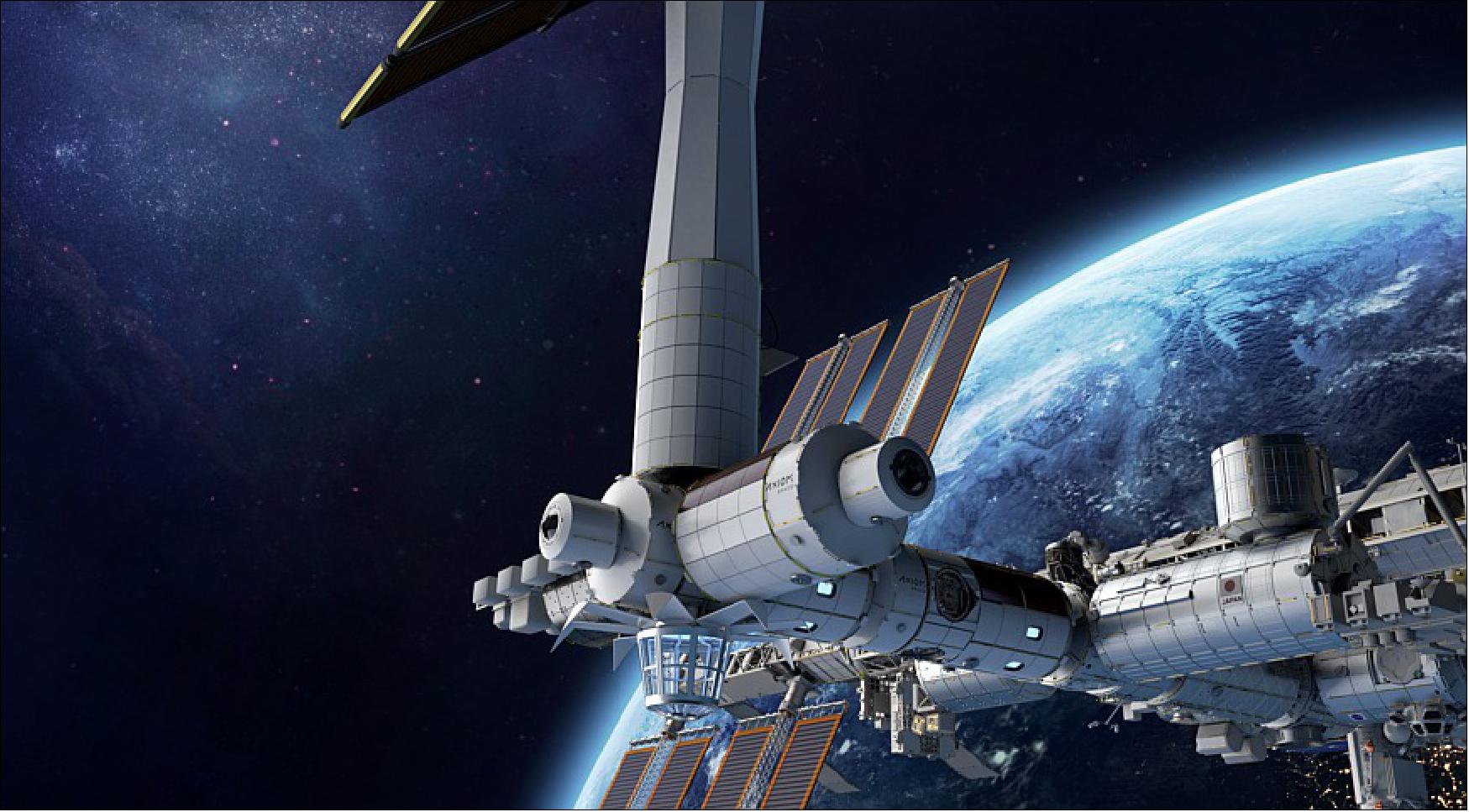
- Saber Astronautics, an Australian space venture with operations in the United States, will use the agreement with Axiom to build up interest in human spaceflight and space-based research. The goal is to give Australian astronauts and space companies “access to the station’s orbiting microgravity laboratory and develop a new generation of products for human health, materials, electronics, clean tech and more,” Saber said.
- “Saber is already reaching out to commercial organizations and private individuals to gauge interest in their participation in future Axiom missions,” said a spokesperson.
- Axiom’s first mission Ax-1 will bring to the ISS three private customers from the United States, Canada and Israel. They will perform 25 experiments over a one week stay on the station.
- Saber owns and operates the Responsive Space Operations Centre (RSOC) based in Adelaide and Colorado. The Adelaide RSOC last year received $6 million in funding from the Australian Space Agency’s space infrastructure fund. “Supporting astronauts is a long-term goal of Saber’s RSOC program accelerated by the agreement with Axiom,” the company said.
- The program to be run by Saber will train the companies that participate as well as help them determine which products can benefit from research and experiments on the ISS, said Saber. “This allows a path for Australians to be astronauts and work independently without requiring a change of citizenship to the U.S. or European Union.”
• November 21, 2021: The three private astronauts on Axiom Space’s first mission to the International Space Station next February will perform more than 100 hours of research on their flight as the company works to advance plans for its own space station. 18)
- Axiom Space announced Nov. 17 that the three customers it is flying on the Ax-1 mission, scheduled for launch 21 February 2022 on a SpaceX Crew Dragon spacecraft, will perform 25 experiments during the roughly one week they will spend on the station.
- Larry Connor, an American real estate entrepreneur, will be conducting research for the Mayo Clinic and the Cleveland Clinic. That research will focus on heart health and the effects of space environment on spinal and brain tissue.
- Mark Pathy, chief executive of a Canadian investment firm, will conduct research for several Canadian organizations. That work includes research on chronic pain and sleep disturbances experienced by space travelers, studies on changes in visual acuity, and Earth observation for climate change and ecology research.
- Eytan Stibbe, a former Israeli Air Force pilot who is the founding partner of an “impact investment” fund, will do research for the Ramon Foundation and Israel Space Agency. He will conduct a suite of experiments in a wide range of disciplines as part of a mission called “Rakia” by its Israeli sponsors.
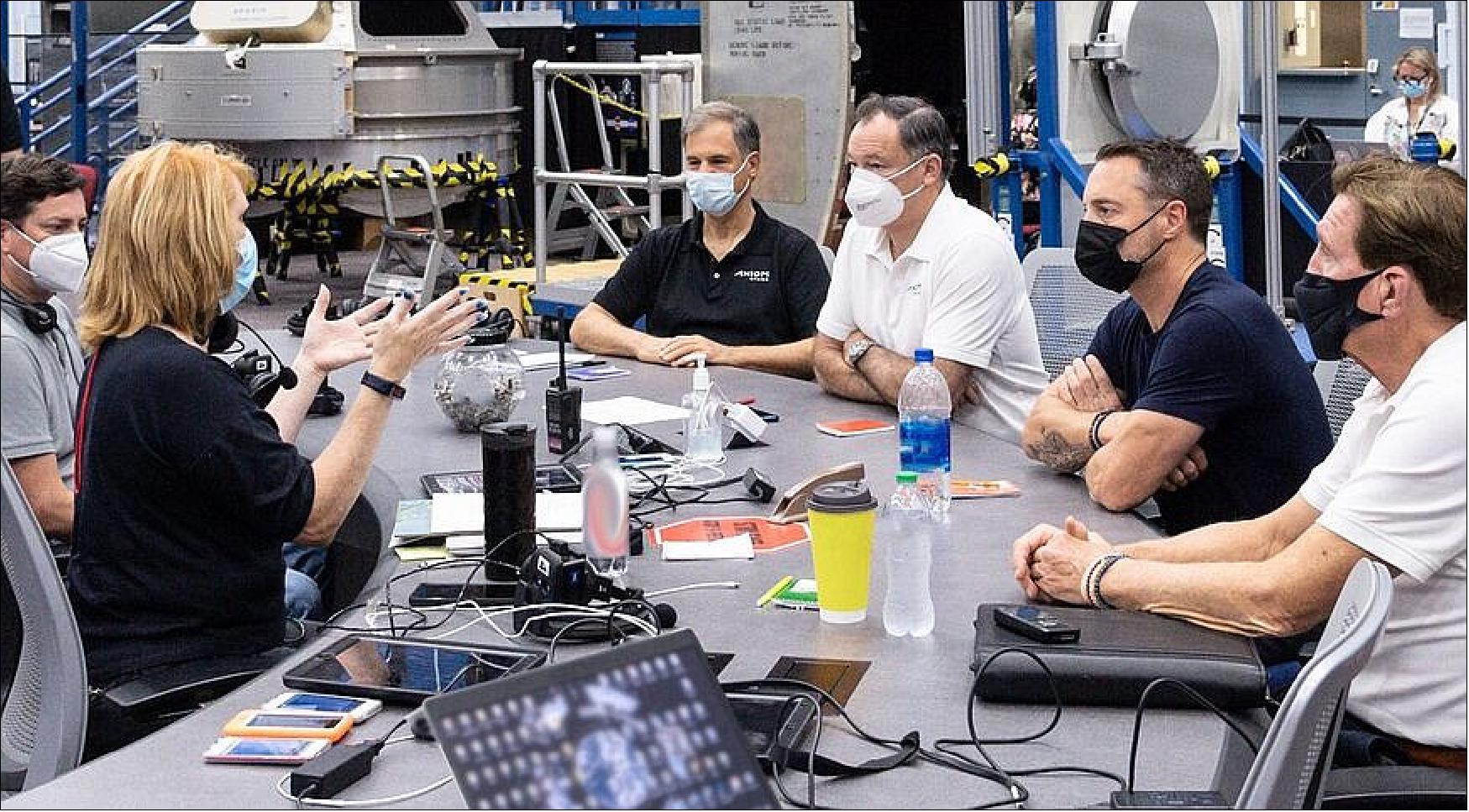
- Axiom executives emphasized the research focus on the mission. “It’s the first commercial mission to the ISS. It’s a pathfinder and it’s very research focused,” said Christian Maender, in-space manufacturing and research director at Axiom, during a panel discussion at the ASCEND conference by the American Institute of Aeronautics and Astronautics Nov. 17. “They’re going to be adding an increasingly complex number of projects to the ISS during their mission.”
- Axiom’s three customers will be joined on that mission by Michael López-Alegría, a former NASA astronaut who will be commander of the mission. The four are currently in training for the mission, including at the Johnson Space Center.
- Ax-1 is the first in a series of private missions Axiom has planned before installing a commercial module there as soon as 2024. Maender said the company is targeting the third quarter of 2022 for its Ax-2 mission, with former NASA astronaut Peggy Whitson as commander and one customer, John Shoffner, as pilot. The company has not announced the other two people flying that mission, and NASA has not confirmed that launch date.
- “We’re doing these series of missions in order to do a couple of things,” Maender said. “First, to develop markets, but also to do pathfinder work towards what is eventually our Axiom station.”
- Axiom plans to install a series of modules on the ISS starting in 2024, building up a commercial segment that will eventually be separated from the ISS to form a commercial station. That could happen as soon as 2027, he said. “We’ll be ready to separate when the business drives us to separate and also when the lifetime of ISS decides that maybe it’s time to go,” he said.
- “We applaud the Ax-1 crew’s commitment to advancing scientific inquiry and kicking off this civilizational leap,” said Michael Suffredini, president and chief executive of Axiom Space, in a statement. “We’re confident this mission will become not just a monumental moment in space travel, but the true beginning of making space’s potential for meaningful discovery available to private citizens and organizations for the first time.”
• July 15, 2021: Thales Alenia Space, a Joint Venture between Thales (67%) and Leonardo (33%), and Axiom Space of Houston, Texas (USA), have signed the final contract for the development of two key pressurized elements of Axiom Space Station - the world’s first commercial space station. Scheduled for launch in 2024 and 2025 respectively, the two elements will originally be docked to the International Space Station (ISS), marking the birth of the new Axiom Station segment. The value of the contract is 110 Million Euro. 19)
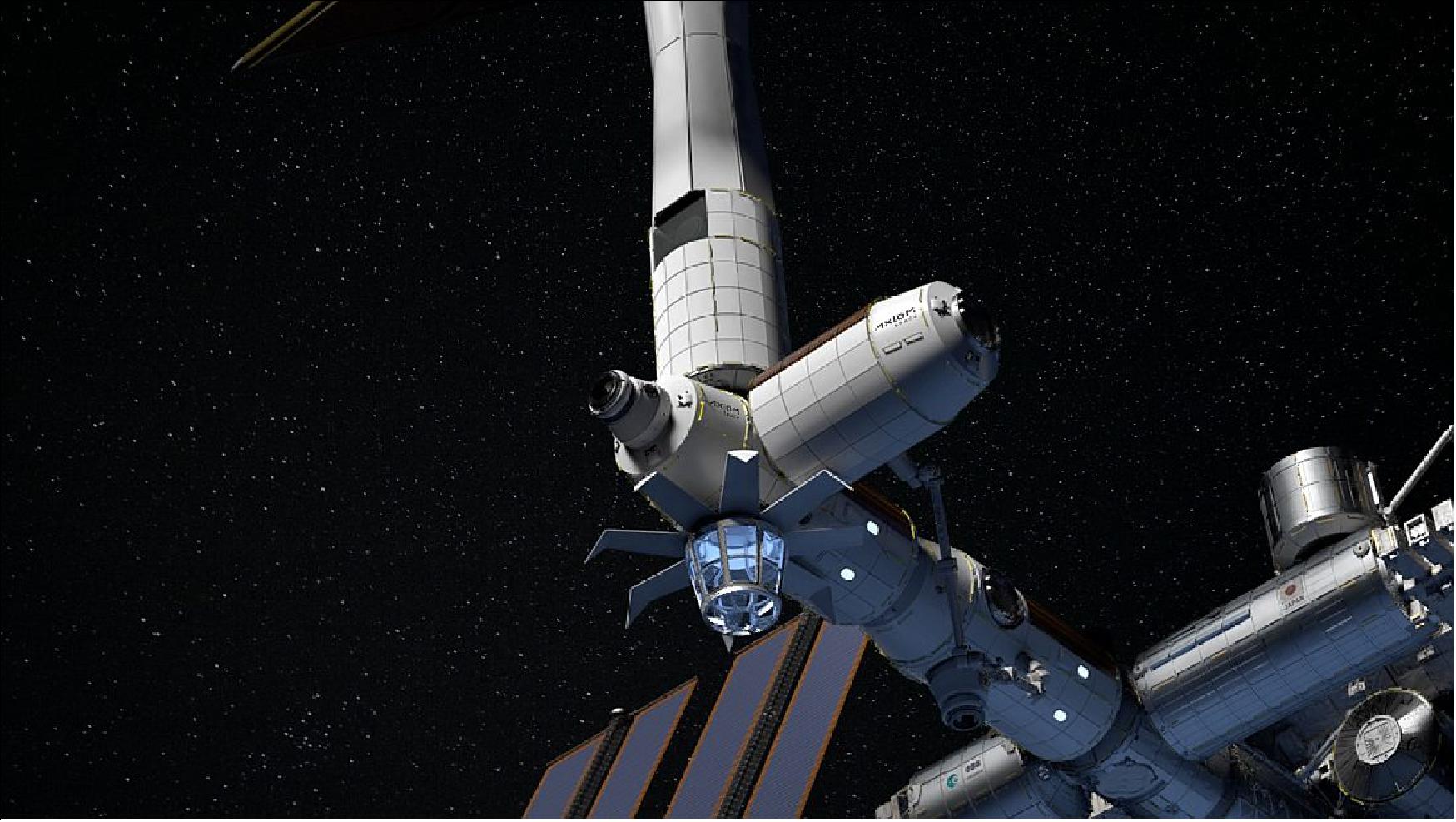
- On this occasion today, Thales Alenia Space and the Italian Air Force have ratified a Memorandum of Collaboration, aiming to promote the access to low earth orbit in favor of institutions, the scientific community, industry and commercial operators, and the development of a research chain on strategic issues (medicine, materials, biogenetics, etc.) as well as to support the possibilities of technological development and OT&E (Operational Testing & Evaluation) in microgravity.
- “The contact signed today with Axiom Space confirms the positioning of Thales Alenia Space as a leading industrial player in the New Space ecosystem, both for private and public missions”, stated Massimo Claudio Comparini, Thales Alenia Space Deputy CEO and Senior Executive Vice President Observation, Exploration & Navigation business line. “With the development of more than 50% of the ISS’ habitable volume, our Company has marked the history since the origins of Orbital Infrastructures programs. Based on this unique legacy, we are pioneering the future of human presence in LEO. We are pushing back the boundaries of space exploration and setting the basis for the Lunar Gateway and the Moon’s Surfaces ecosystem that will lead manned exploration missions to the red planet by the 2030’s. Humankind’s quest of sense in space is becoming a reality and we are so proud to contribute to making it come true”.
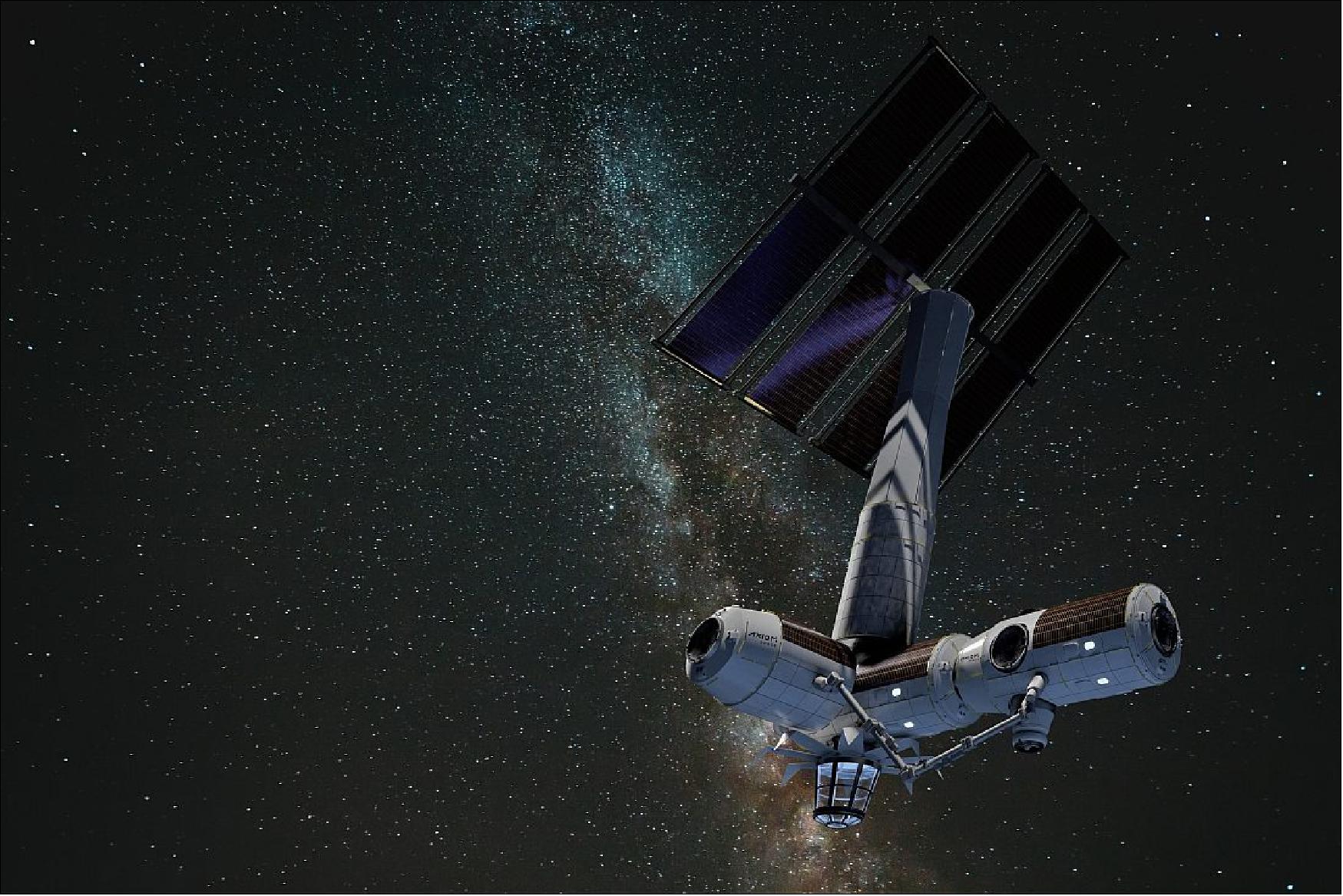
- Based on its past successful experience in building modules for the International Space Station, Thales Alenia Space is responsible for the design, development, assembly and test of the primary structure and the Micrometeoroid & Debris Protection System for the two Axiom modules.
- “We have convened an elite collection of expertise at Axiom to build and operate the world’s first commercial space station, and Thales Alenia Space fits right into that mold as a partner,” Axiom President & CEO Michael Suffredini, who previously served as NASA’s International Space Station Program Manager from 2005 to 2015, said. “This agreement confirms the primary structures for the next-generation destination in space will be constructed with an expert touch, serving as the core of the first human-rated spacecraft to ever be assembled in Houston.”

- The project is currently undergoing a detailed design phase: the four radial bulkheads for the first module have been recently developed in Thales Alenia Space facilities in Turin. These bulkheads provide the structure to which radial Common Berth Mechanisms (CBMs) and hatches will attach. Together, the four bulkheads, with their accompanying hardware form a cylindrical section, providing four ports for other station elements, including docking adapters. The cylindrical protrusions seen on the bottom half of the bulkhead will serve as a connecting unit, allowing power, data, and fluids to pass from one element to another, including Axiom modules and the ISS.
• June 3, 2021: Axiom Space has signed a contract with SpaceX for three additional Crew Dragon missions, enough to meet its projections for private astronaut missions to the International Space Station through at least 2023. 20)
- Axiom, which already has a deal with SpaceX for the Ax-1 mission to the ISS launching in early 2022, said June 2 the new contract covers the projected Ax-2, 3 and 4 missions to the station. All will use Crew Dragon spacecraft launched on Falcon 9 rockets.
- The companies did not disclose the terms of the agreement, including whether Axiom Space negotiated a lower price through a block buy. Axiom spokesman Beau Holder told SpaceNews that the biggest benefit of the agreement was ensuring access to the Crew Dragon for its future missions.
- “It secures a vehicle that is flight-proven and ready to support the crewed launch cadence Axiom is planning: approximately every six or seven months leading up to near the launch of the first Axiom module to ISS,” he said. “Expanding this partnership between two key industry leaders cements the commercialization of low Earth orbit.”
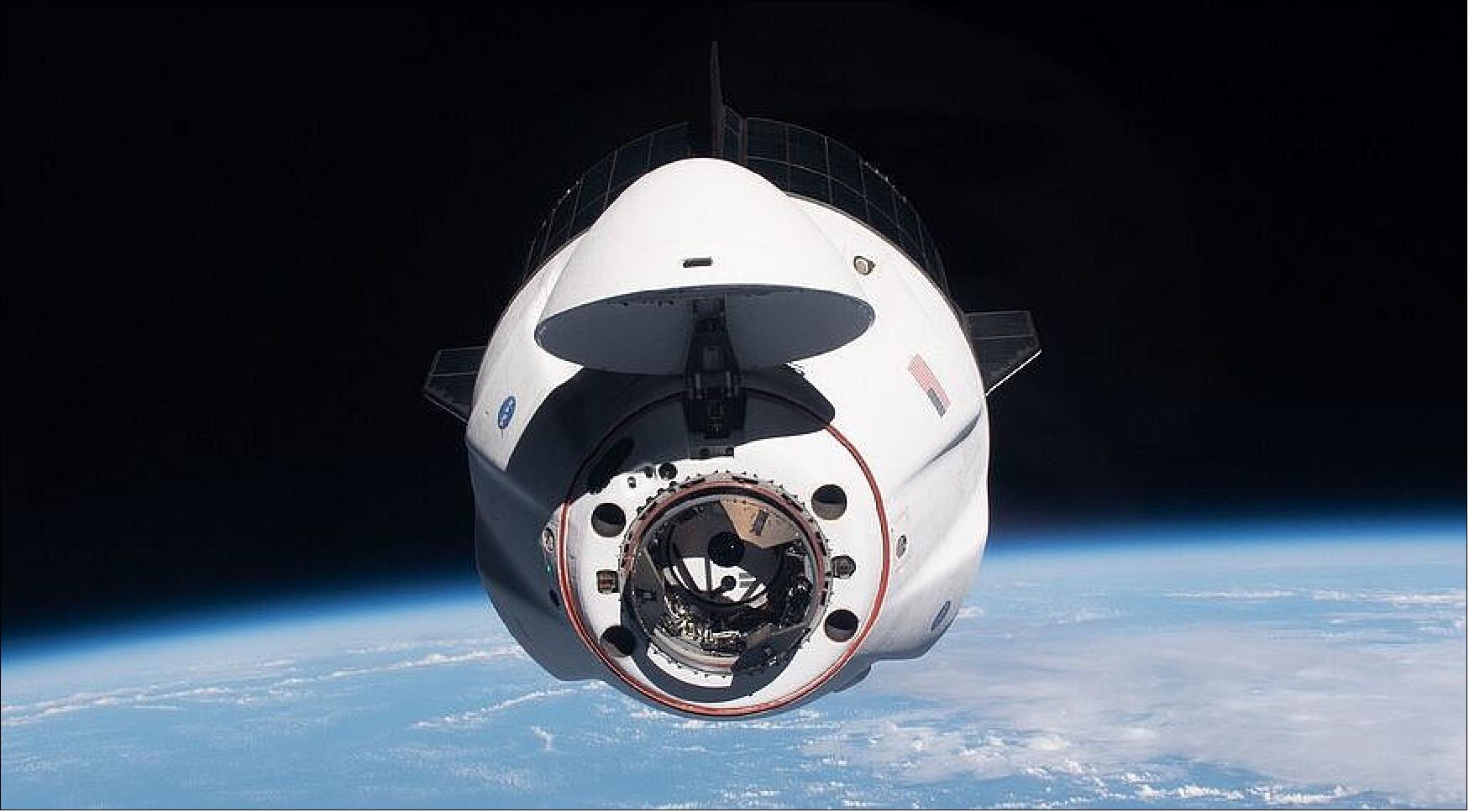
- Axiom finalized an agreement with NASA for the Ax-1 mission May 10. That Crew Dragon mission, scheduled for launch in early 2022, will be commanded by former NASA astronaut Michael López-Alegría with three customers: Larry Connor, Mark Pathy and Eytan Stibbe.
- Axiom announced May 25 that another former NASA astronaut, Peggy Whitson, will command the Ax-2 mission. She will fly with John Shoffner, a private astronaut, and two additional customers to be announced. Axiom did not disclose at the time what vehicle the two would use for that mission, but Whitson and Shoffner had already been assigned as backups for the Ax-1 mission.
- Michael Suffredini, Axiom’s president and chief executive, said last month that the company had missions lined up through Ax-4, but did not disclose details about who would fly on those missions or when they would launch. “We still have to work with NASA to figure out exactly when those flights can come to the ISS,” he said at a NASA briefing about Axiom’s agreement for the Ax-1 mission.
- NASA’s low Earth orbit commercialization strategy, announced two years ago, allows two private astronaut missions a year to the ISS. That is based on the amount of traffic from other visiting vehicles to the station, and NASA officials said last month they don’t envision increasing that in the near future.
- The new contract would allow Axiom to fly missions to the station through 2023, if it is able to secure agreements for the other private astronaut mission opportunities in 2022 and 2023. “We’re prepared to fly on a cadence of about twice a year, but like everyone, we have to compete for the opportunity,” Suffredini said at the briefing.
- SpaceX, in a separate statement, sounded optimistic about Axion’s chances of securing those additional ISS private astronaut missions, noting that the agreement covers “three additional private crew missions aboard Dragon to and from the Station through 2023.”
- In addition to Axiom, SpaceX is flying the Inspiration4 mission on a Crew Dragon launching this fall. That mission, commanded by billionaire Jared Isaacman, will not dock with the ISS but instead fly in a higher orbit for three days before returning.
- Space Adventures announced February 2020 an agreement with SpaceX for a similar Crew Dragon mission, one that would spend several days in orbit but not visit the ISS. At the time Space Adventures said the mission would take place between late 2021 and the middle of 2022, but the company has not updated on the schedule for the mission or announced who will fly on it.
- “We are beyond excited to build upon our partnership with Axiom to help make human spaceflight more accessible for more people,” Gwynne Shotwell, president of SpaceX, said in a statement. “A new era in human spaceflight is here.”
• May 25, 2021: A former NASA astronaut who holds the record for the most time spent in space by an American will command Axiom Space’s second commercial mission to the International Space Station, the company announced May 25. 21)
- Axiom said that Peggy Whitson will serve as commander of the Ax-2 mission to the ISS. She will be joined by John Shoffner, a private astronaut from Knoxville, Tennessee, who will be a customer of the mission and serve as pilot.
- Whitson joined the NASA astronaut corps in 1996 after several years at NASA as a research scientist. She was on the ISS for three-long duration missions in 2002, 2008 and 2016–17, spending 665 days in space, the most for any American astronaut but trailing eight Soviet and Russian cosmonauts. She performed 10 spacewalks over those three ISS missions.

- Whitson, who also served as chief of NASA’s Astronaut Office, retired from NASA in June 2018. She joined Axiom as an astronaut consultant and was named in January to be the backup commander for Axiom’s Ax-1 mission to the ISS, commanded by Michael López-Alegría, another former astronaut.
- “I’m thrilled to get to fly to space again and lead one of these pioneering missions, marking a new era of human spaceflight,” Whitson said in the statement.
- Shoffner is also training as the backup pilot for Ax-1. He is a pilot and auto racer with an interest in life sciences research. Shoffner and Whitson plan to train for both spacecraft operations as well as genomics research, the latter being done with 10x Genomics, a California biotechnology company.
- Shoffner said in the statement that it was an “honor” to train with Whitson for the upcoming flight, and was excited about the prospect of doing biotech research on the station. “I look forward to the process of testing and validating this technology for future groundbreaking work in low Earth orbit,” he said.
- “In the time we’ve already spent together as crewmates, it’s clear to me that John will be an excellent pilot and researcher,” Whitson said of Shoffner. “It’s a pleasure to take him under my wing.”
- Axiom, in its announcement of Whitson and Shoffner, did not disclose when Ax-2 would launch, or even what spacecraft the mission will use. The Ax-1 mission, flying on a SpaceX Crew Dragon spacecraft, is scheduled for no earlier than January 2022. NASA is offering up to two private astronaut missions a year to the ISS, but Axiom will have to compete with other companies for those missions.
- “We are seeing a lot of interest in private astronaut missions, even outside of Axiom,” Angela Hart, manager of commercial low Earth orbit development at NASA’s Johnson Space Center, said at a May 10 briefing where NASA announced it had finalized an agreement with Axiom for the Ax-1 mission. That interest, she said, exceeded the supply of mission opportunities.
- Michael Suffredini, president and chief executive of Axiom Space, said at that briefing that his company had lined up not just Ax-1 and 2 but also a third and fourth mission, but disclosed no details about those later missions. “We’re prepared to fly on a cadence of about twice a year, but like everyone, we have to compete for the opportunity,” he said then.
- Axiom did not announce who will fly with Whitson and Shoffner on Ax-2. However, the television network Discovery announced May 18 that the winner of a reality TV show it is developing, called “Who Wants to Be an Astronaut?”, will fly on the Ax-2 mission, spending eight days on the ISS.
- Discovery billed the show as a “real-life space adventure,” putting contestants through a series of “extreme challenges” over eight episodes to see who is best suited for a flight to space. The announcement didn’t describe the selection process for contestants, but noted that a “panel of expert judges” will pick the winner, who will fly on Ax-2.
• May 11, 2021: NASA says it’s seeing strong interest from companies proposing private astronaut missions to the International Space Station, with the demand for such missions exceeding the agency’s ability to accommodate them. 22)
- NASA announced May 10 that it had finalized an agreement with Axiom Space for that company’s first crewed mission to the station, scheduled for launch no earlier than January 2022. The Ax-1 mission, announced in January, will fly three paying customers on a SpaceX Crew Dragon spacecraft commanded by former NASA astronaut Michael López-Alegría.
- Preparations for the mission are underway, NASA and Axiom officials said at a briefing. The three people joining López-Alegría on Ax-1 — Larry Connor, Mark Pathy, and Eytan Stibbe — will undergo centrifuge and zero-g training next week. López-Alegría said he will start full-time training for the mission in August. Connor, designated as the pilot for the mission, will start training in September, with Pathy and Stibbe to follow in October.
- The mission will last 10 days, including seven to eight docked to the ISS. Michael Suffredini, president and chief executive of Axiom Space, said preparations for the mission were on schedule. “We have a high degree of confidence in the late January date” for launching Ax-1, he said.
- That mission is the first in a series Axiom Space plans to fly to the ISS as it develops a series of commercial modules it will add to the station beginning as soon as 2024, which themselves will be the core of a future stand-alone space station. “We’ve got things lined up for next three flights, Ax-2, 3 and 4,” he said. “We still have to work with NASA to figure out exactly when those flights can come to the ISS.”
- Those private astronaut missions are enabled by NASA’s low Earth orbit commercialization policy announced nearly two years ago, which allows two such missions a year and also sets aside resources on the ISS for commercial applications. Axiom is the first company to sign an agreement with NASA for a private astronaut mission, but the agency said it’s seeing strong interest in general for such missions.
- “We are seeing a lot of interest in private astronaut missions, even outside of Axiom,” said Angela Hart, manager of commercial low Earth orbit development at NASA’s Johnson Space Center. “At this point, the demand exceeds what we actually believe the opportunities on station will be.”
- Opportunities for private astronaut missions are limited by what NASA calls the “traffic model” for the ISS, or the schedule of vehicles arriving and departing the station. Commercial crew missions are limited to two docking ports on the station, one of which is occupied by the vehicle that transported the current long-duration crew on the station. The other is used by commercial crew vehicles during crew handovers, cargo Dragon missions and private astronaut missions.
- That restricts the opportunities for private astronaut missions. “About two is about all you fit in there with the rest of the traffic,” Dana Weigel, deputy manager of the ISS program at JSC, said.
- Axiom hopes to seize those opportunities, with Suffredini stating that his company would like to fly private astronaut missions at the rate of two per year. “We’re prepared to fly on a cadence of about twice a year, but like everyone, we have to compete for the opportunity,” he said.
- NASA recently changed the pricing policy for private astronaut missions, significantly increasing the prices it charges companies seeking to fly such missions to cover “full reimbursement for the value of NASA resources” used to support them. However, the agreement for Ax-1 was completed under the 2019 pricing policy.
- Thanks to an exchange of services between NASA and Axiom, it will actually be NASA paying Axiom for the Ax-1 mission. While Axiom is acquiring services such as crew supplies and on-orbit resources, NASA will be purchasing “cold stowage” space on the Crew Dragon spacecraft to return cargo to Earth at the end of the mission. NASA will pay Axiom $1.69 million for the mission, although Hart noted there will be other charges to Axiom for training and launch services, some of which are still being negotiated.
- Suffredini said that, on later missions, Axiom will seek to reduce its reliance on NASA services. “We have a goal that, by after our third flight, we will provide all of those kinds of capabilities” that it is currently purchasing from NASA.
- Phil McAlister, director of commercial spaceflight development at NASA Headquarters, said the Axiom agreement was the latest sign of a burgeoning commercial human spaceflight industry, which includes the series of Crew Dragon missions to the ISS, the planned Inspiration4 mission this fall and suborbital spaceflight activities by Blue Origin and Virgin Galactic.
- “This truly is a renaissance in U.S. human spaceflight. I think that’s the perfect word for what we’re experiencing,” he said. “It’s just what we envisioned for the commercial crew program when we embarked on that about 10 years ago.”
• May 10, 2021: NASA and Axiom Space have signed an order for the first private astronaut mission to the International Space Station to take place no earlier than January 2022. 23)
- “We are excited to see more people have access to spaceflight through this first private astronaut mission to the space station,” said Kathy Lueders, associate administrator for human exploration and operations at NASA Headquarters. “One of our original goals with the Commercial Crew Program, and again with our Commercial Low-Earth Orbit Development Program, is that our providers have customers other than NASA to grow a commercial economy in low-Earth orbit.”
- The spaceflight, designated as Axiom Mission 1 (Ax-1), will launch from NASA’s Kennedy Space Center in Florida and travel to the International Space Station. Once docked, the Axiom astronauts are scheduled to spend eight days aboard the orbiting laboratory. NASA and Axiom mission planners will coordinate in-orbit activities for the private astronauts to conduct in coordination with space station crew members and flight controllers on the ground.
- Axiom will purchase services for the mission from NASA, such as crew supplies, cargo delivery to space, storage, and other in-orbit resources for daily use. NASA will purchase from Axiom the capability to return scientific samples that must be kept cold in transit back to Earth.
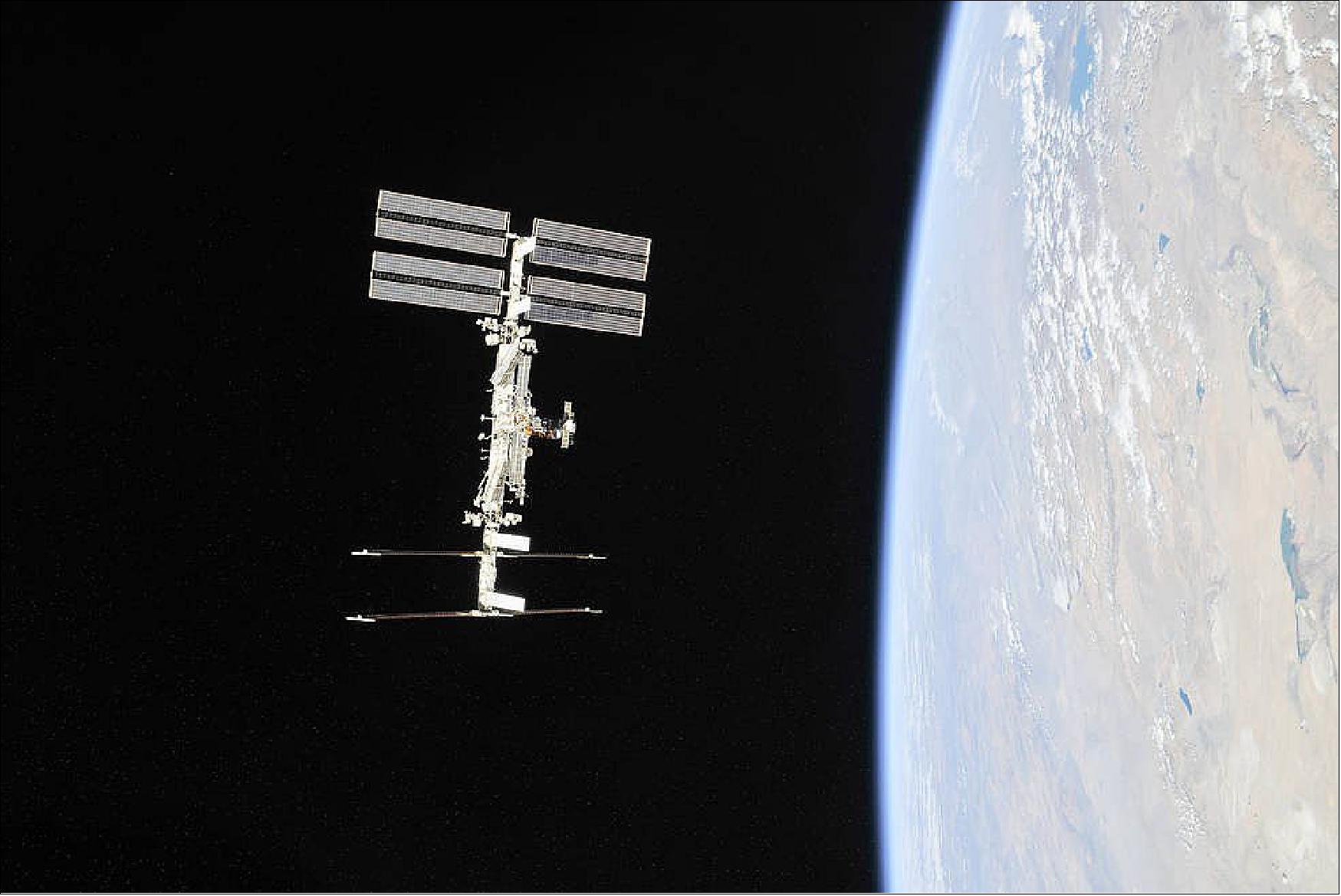
- “The first private crew to visit the International Space Station is a watershed moment in humanity’s expansion off the planet and we are glad to partner with NASA in making it happen,” said Axiom President and CEO Michael Suffredini. “A thriving commercial marketplace in low-Earth orbit begins with expanding access to serious, nontraditional users and that is exactly the aim of our private astronaut missions.”
- NASA has opened up the space station for commercial activities, including private astronaut missions, as part of its plan to develop a robust and competitive economy in low-Earth orbit. The agency’s needs to achieve that goal – such as research on the effects of the space environment on humans, technology development, and in-flight crew testing – will remain in place after the retirement of the International Space Station. Commercial entities can meet those needs, providing destinations and transportation capabilities. Enabling Ax-1 is an important step to stimulate demand for commercial human spaceflight services so NASA can be one of many customers in low-Earth orbit.
- For the Ax-1 mission, Axiom has proposed Michael López-Alegría, Larry Connor, Mark Pathy, and Eytan Stibbe as prime crew members. These private astronauts will be reviewed by NASA and its international partners, as is standard for any space station crew, and undergo NASA medical qualification testing to be approved for flight. López-Alegría will serve as the mission commander, with Peggy Whitson and John Shoffner as backups.
- Once the proposed crew passes review and qualification, the four members will train for their flight with NASA, international partners, and SpaceX, which Axiom has contracted as launch provider for transportation to the space station. Trainers will familiarize the private astronauts with systems, procedures, and emergency preparedness for the space station and the Crew Dragon spacecraft. Based on current mission planning, training is scheduled to begin this summer.
- The development and growth of the low-Earth orbit economy continues. In January 2020, NASA selected Axiom to provide at least one habitable commercial module to be attached to the forward port of the International Space Station’s Harmony node in late 2024. Most recently, NASA announced the agency is seeking input from industry on future commercial low-Earth orbit destinations that will provide services, such as crew training, scientific research, and advanced systems development for both government and private-sector astronauts and customers.
- For more than 20 years, NASA has supported a continuous U.S. human presence in low-Earth orbit. The agency's goal is a low-Earth orbit marketplace where NASA is one of many customers, and the private sector leads the way. This strategy will provide services the government needs at a lower cost, enabling the agency to focus on its Artemis missions to the Moon and on to Mars while continuing to use low-Earth orbit as a training and proving ground for those deep space missions.
• February 16, 2021: Axiom Space announced Feb. 16 it has raised $130 million from a group of investors, allowing the company to push ahead with its long-term ambitions of establishing a private space station. 24)
- The Series B round was led by C5 Capital, a firm that invests in cybersecurity and “closely aligned” sectors, including space. Others participating in the round include TQS Advisors, Declaration Partners, Moelis Dynasty Investments, Washington University in St. Louis, The Venture Collective, Aidenlair Capital, Hemisphere Ventures and Starbridge Venture Capital.
- The funding will allow the company to expand, including doubling its current workforce of about 110 people this year, Michael Suffredini, president and chief executive of Axiom, said in an interview. It will also support quarterly payments to Thales Alenia Space, which is building the pressurized elements of the first modules. The company recently moved into a two-story building in Houston and is buying a new test facility, with plans to establish a campus at Spaceport Houston, also known as Ellington Airport.
- “This is a really the major step for us,” he said. “The B round is typically where you get your first large investment, but more importantly than the money is the community of investors that you put together, so that future rounds are largely from those investors.” That group of investors, he said, was “a perfect fit for us and puts us in a good position, however we want to go forward.”
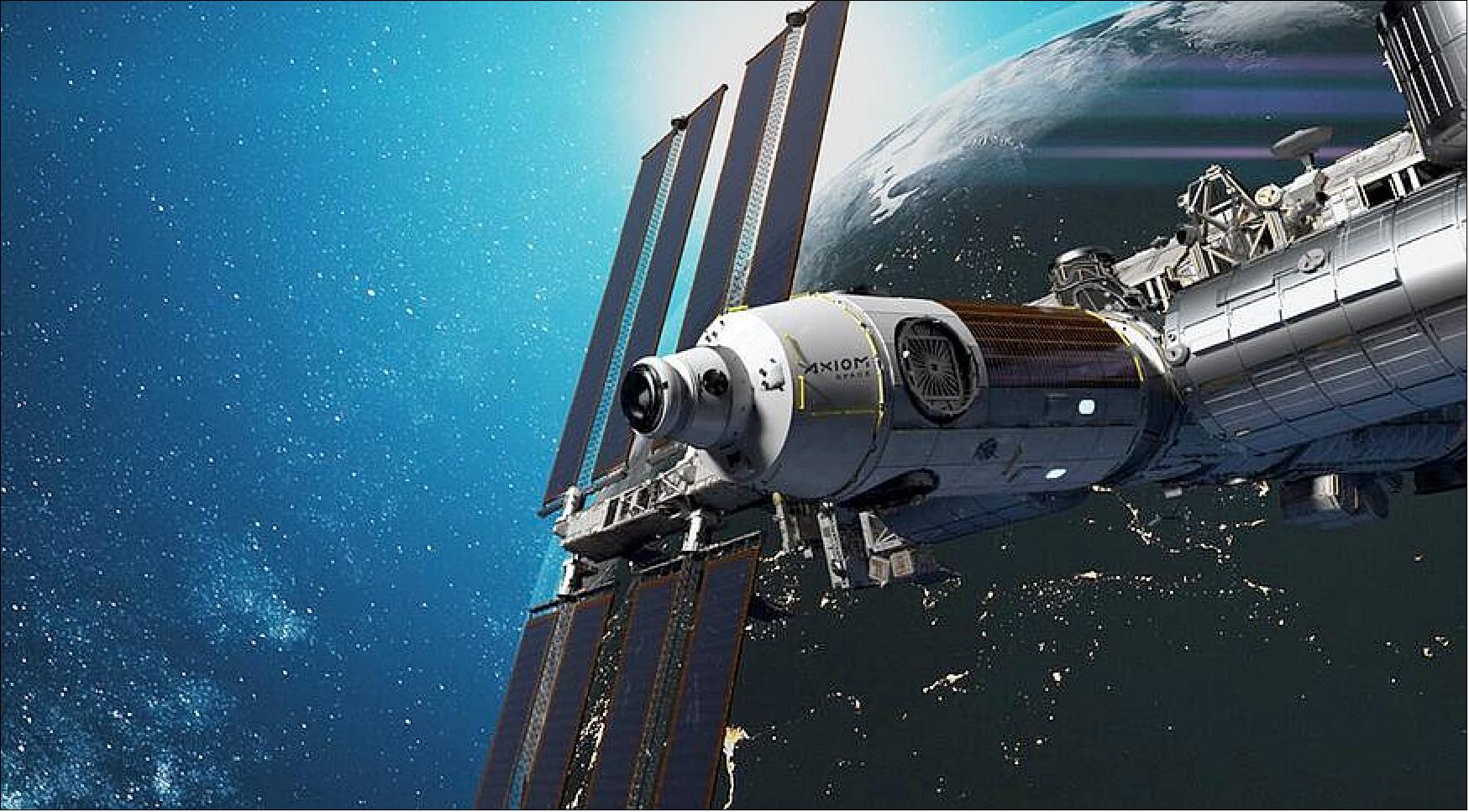
- As part of the deal, Rob Meyerson, an operating partner at C5 and former longtime president of Blue Origin, will join Axiom’s board. “Axiom Space is a force in the space sector, and it will become a centerpiece of the C5 Capital portfolio and enhance our vision for a secure global future,” Meyerson said in a statement about the investment round.
- “It’s fantastic that Rob Meyerson is part of C5,” Suffredini said. “He’s got this huge amount of experience. We’re excited to have him on the board.”
- While the funding round advances Axiom’s plans to place a series of commercial modules on the International Space Station starting in 2024, which will ultimately form the core of a standalone commercial station, Suffredini acknowledged the company will need to raise more money.
- “It’s probably between half a billion and a billion dollars that ultimately we’ll raise to build our space station,” he said. That project will have an overall cost of about $3 billion, but most of that will come from revenue from operations.
- The next funding round will come as soon as this fall, he said. That could be another private round or by going public. If the latter, that would likely be done through a merger with a special-purpose acquisition company (SPAC), an approach used by a growing number of space companies, including Virgin Galactic and Astra.
- The demand for those commercial modules and, eventually, standalone space station will change over time. Initially, demand will come in large part from flying private and professional astronauts, with research playing a smaller role. “I think the future is manufacturing in space,” Suffredini said. “About 15 years from now, that’s going to eclipse all the other markets by far.”
- The statement about the funding round hinted at other applications of the modules. “Axiom Station will play an important role in future missions critical to preserving our national security and fighting climate change,” said Mike Mullen, a retired admiral and former chairman of the Joint Chiefs of Staff who is now a partner at C5 Capital.
- Suffredini confirmed that national security applications could be a future market for Axiom’s station. “It’s our belief that humans in space and support of that is going to be necessary” for the new U.S. Space Force, he said, although the Space Force has not announced any plans to deploy personnel in space for the foreseeable future.
- The Axiom facility, he said, could host payloads for Earth observation and monitoring climate change. The ISS currently is used for some Earth science experiments.
- Axiom’s near-term plans involve flying people to the ISS on commercial crew spacecraft, starting with the Ax-1 mission in early 2022, whose crew the company announced Jan. 26. Preparations for that mission are going well, Suffredini said, although training won’t begin in earnest for a few months.
- “We have quite a few in the hopper,” Suffredini said of future missions. Axiom has signed one customer for its second flight and working on signing the other two, and has identified the commander for that mission. A third mission is fully booked, while at least one customer is in the process of signing up for a fourth mission.
- Axiom has about a dozen prospective customers that it’s in discussions with. “Out of a dozen maybe three will ultimately fly, maybe four,” he said. “It just takes time. In a lot of cases they just have to think about it a lot. It’s a big thing to fly to space.”
- Those missions would fly through 2023 at about two per year, pending approvals from NASA. “We have to come in and make our case for our flights,” he said. “The most important thing is to get your customers signed.”
• January 26, 2021: Axiom Space on Tuesday announced its crew for humankind’s first flight of a group of private individuals to a Low Earth Orbit destination – the first-ever entirely private mission proposed to fly to the International Space Station (ISS). 25)

- López-Alegría, who flew to space four times over a 20-year, record-setting career at NASA and last visited the ISS in 2007, will become the first person to ever command both a civil and a commercial human spaceflight mission. Connor will be the first private mission pilot in the annals of spaceflight.
- Pathy will be Canada’s 11th astronaut. Stibbe, a close personal friend of Columbia astronaut Ilan Ramon and a former Israeli Air Force pilot, will be Israel’s second. Both will fly as mission specialists.
- “This collection of pioneers – the first space crew of its kind – represents a defining moment in humanity’s eternal pursuit of exploration and progress,” López-Alegría said. “I know from firsthand experience that what humans encounter in space is profound and propels them to make more meaningful contributions on returning to Earth. And as much as any astronaut who has come before them, the members of this crew have accomplished the sorts of things in life that equip them to accept that responsibility, act on that revelation, and make a truly global impact.
- “I look forward to leading this crew and to their next meaningful and productive contributions to the human story, both on orbit and back home.”
- Former NASA astronaut Peggy Whitson will serve as Ax-1’s backup commander, while John Shoffner of Knoxville, Tenn. is the backup mission pilot. Carrying a time-honored approach over from the civil spaceflight era to the private one, the prime and backup crews are slated to go through Axiom’s full training program together.
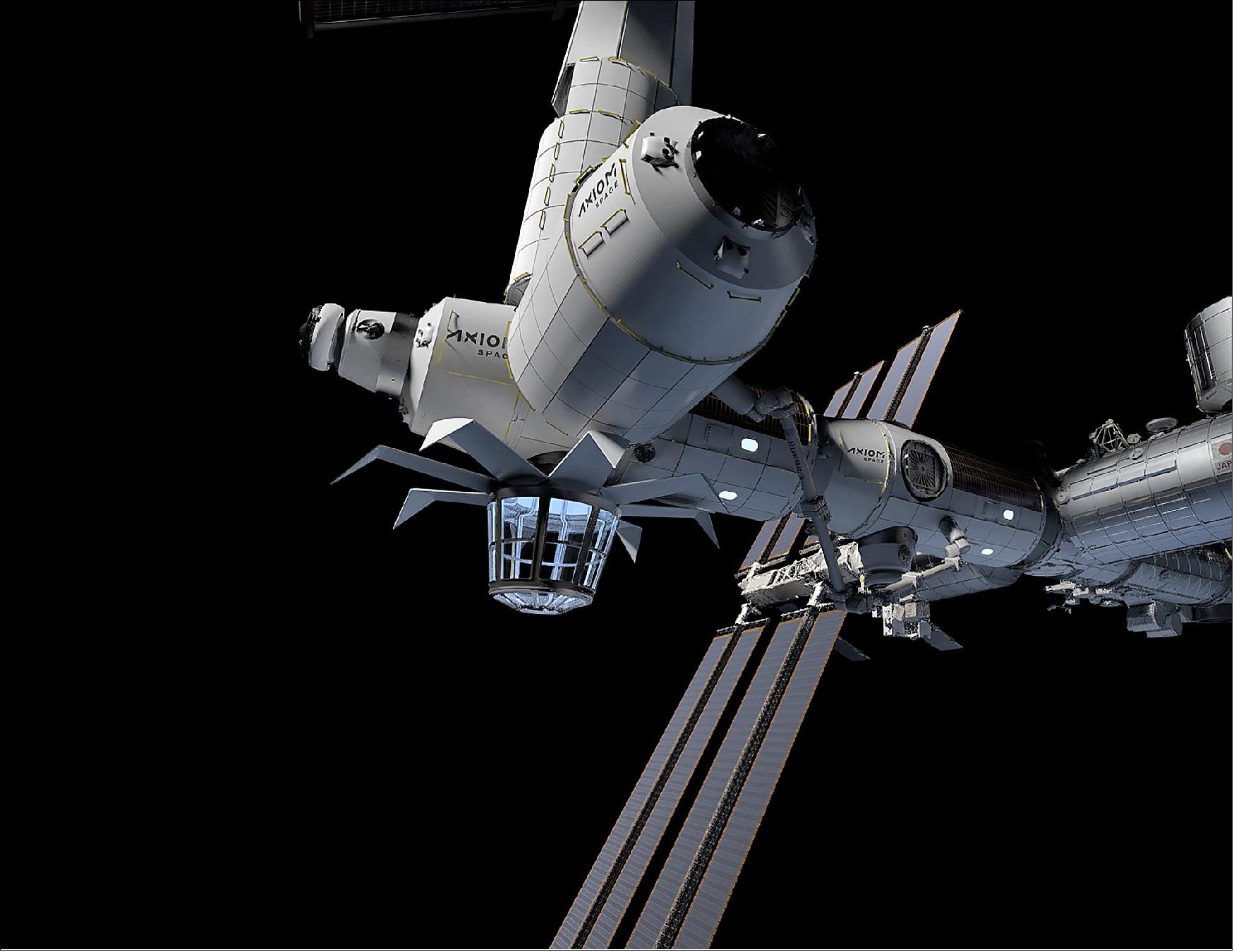
• October 23, 2020: Axiom Space hopes to soon finalize its first commercial mission to the International Space Station, scheduled for late 2021, as it continues development of a commercial module for the station. 26)
- During a panel discussion at the International Astronautical Congress (IAC) Oct. 13, Michael Suffredini, president and chief executive of Axiom Space, said his company had lined up the customers for that first mission, a 10-day flight to the space station on a SpaceX Crew Dragon spacecraft scheduled for the fourth quarter of 2021.
- “We have all of our customers identified and we’re about to finish their contracting,” he said. The company previously announced a contract with SpaceX for the flight and is “just about done” with a NASA contract for the mission.
- “We’re cautiously optimistic that, by the end of October, we will have everything in place to move forward for a launch in the fourth quarter of 2021,” he said.
- That mission is expected to feature three customers along with one Axiom astronaut, Michael Lopez-Alegria, a former NASA astronaut. Axiom has not disclosed who those customers are, although there has been widespread speculation that they will include the actor Tom Cruise. NASA previously confirmed it has been in discussions with Cruise about shooting a movie on the station.
- Axiom Space is using missions like this as precursors to the series of commercial modules that it is building for the station, after winning a NASA competition to access a docking port there in January. Those modules will form the core of a commercial space station that will detach from the ISS when it reaches the end of its life, currently projected to be 2028 to 2030.

- Axiom announced Oct. 22 that it had completed a system requirements review for that initial module, allowing the company to proceed into its preliminary design phase. Axiom plans to launch that module in 2024.
- “We think it’s very important to begin attached to the International Space Station,” Suffredini said, in order to help users make the transition from the ISS to a commercial facility. “We believe building a platform attached to ISS, so that the users of the International Space Station, commercial and government, have a place to evolve to, is critically important to the success of growing an economy in low Earth orbit.”
• August 27, 2020: While NASA seeks to eventually transition from the International Space Station to commercial stations in low Earth orbit, the agency is putting on hold a solicitation to support development of such a free-flying platform. 27)
- One element of NASA’s LEO commercialization strategy, announced in June 2019, was to fund development of commercial platforms, including both modules attached to the ISS as well as commercial stations. Through NASA’s Next Space Technologies for Exploration Partnership (NextSTEP) program, it solicited proposals for a commercial module attached to the ISS, selecting Axiom Space in January.

- NASA had also planned to use the NextSTEP program for a separate solicitation, known as Appendix K, to support development of a standalone, or free-flyer, commercial station. However, after issuing a draft solicitation last October and holding an industry day in November, the agency did not issue a final solicitation.
- At a session of the ISS Research and Development Conference held online Aug. 27, agency officials confirmed they don’t plan to pursue the free-flyer solicitation for the time being. “We are reevaluating how we want to do that solicitation,” said Angela Hart, LEO commercialization manager at NASA. “At this time we will not be moving forward with Appendix K.”
- She did not elaborate on the specific issues with the solicitation that led to that decision, but emphasized that the agency is still interested in supporting development of commercial space stations. “It’s still a very important part of that overall strategy, so we will be doing that in the future,” she said.
- “We definitely want to do a free-flyer acquisition,” said Phil McAlister, director of commercial spaceflight programs at NASA, in the same panel. “I can’t promise any specific timelines associated with that, but we are definitely working on the free flyer and intend to release a solicitation soon on that once we get our strategy all agreed to internally.”
- Development of commercial space stations is part of NASA’s long-term effort to gradually transition from the ISS to commercial platforms. “At some point in the future, we are going to incrementally phase down ISS operations,” he said, noting there was no specific date for ending the ISS. “Right now, we don’t have any commercial destinations in space, so we’re going to be, for the next several years, working on developing those systems.”
- The goal, he said, was to have more than one commercial station in orbit that NASA can use as one of many government and private customers. “We want to use competition,” he said. “We do want to have more than one platform when we get there.”
- One near-term challenge to that is funding. NASA requested $150 million for its LEO commercialization efforts in its fiscal year 2020 budget proposal, but only received $15 million. NASA again requested $150 million for the program in its fiscal year 2021 request. The House allocated only $15 million for it in its version of a spending bill, while the Senate has yet to take action on its version.
- “This year we only got $15 million. That doesn’t enable a whole lot of spacecraft development,” McAlister said. “We need to do a better job there telling our story.”
- He added that, in the longer term, he hopes to help support development of commercial facilities through lower transportation costs. “Every study has identified high transportation costs as a drag, an impediment, to commercial operations,” he said. NASA will recompete its existing commercial crew and cargo contracts around middle of the decade, “I am going to really push hard for us to reduce those transportation costs. That’s going to be a real goal for NASA.”
- Another nearer-term opportunity to support LEO commercialization is through what NASA calls “private astronaut missions,” or commercial crew missions dedicated to carrying private customers rather than NASA astronauts. NASA’s LEO commercialization strategy calls for allowing up to two such missions a year, for up to 30 days at a time.
- Hart said NASA has received a number of proposals from industry for such missions, which will be reviewed by a new panel her office will set up. That includes two “mission-specific proposals” currently being considered. She declined to discuss details about those proposed private missions, citing “proprietary considerations” involving them.
- One possible customer for one of those private astronaut missions is the actor Tom Cruise, who is seeking to film a movie on the ISS. NASA Administrator Jim Bridenstine tweeted in May that NASA “is excited to work with Tom Cruise on a film aboard the space station,” but did not disclose additional details.
- Bridenstine, in recorded remarks at the conference, alluded to that effort although did not mention Cruise by name. “Right now we’re looking at how do we take astronauts that might be interested in maybe making a movie,” he said of ISS commercialization activities. “If a famous actor wants to make a movie, we support that.”
• June 24, 2020: Thales Alenia Space, Joint Venture between Thales (67 %) and Leonardo (33 %) of Turin, Italy, announced the signature of an ATP (Authorization To Proceed) with Axiom Space of Houston, Texas to initiate the development of two key pressurized elements dedicated to the world’s first commercial space station. 28)
- In January, NASA selected Axiom’s proposal to attach its space station modules to the International Space Station (ISS) starting from the second half of 2024, ultimately creating a new ‘Axiom Segment’ which will expand the usable and habitable volume of the ISS. When the ISS reaches its retirement date, the Axiom complex will detach and operate as a free-flying commercial space station. The Axiom Segment will be attached to the ISS Node 2 built by Thales Alenia Space.
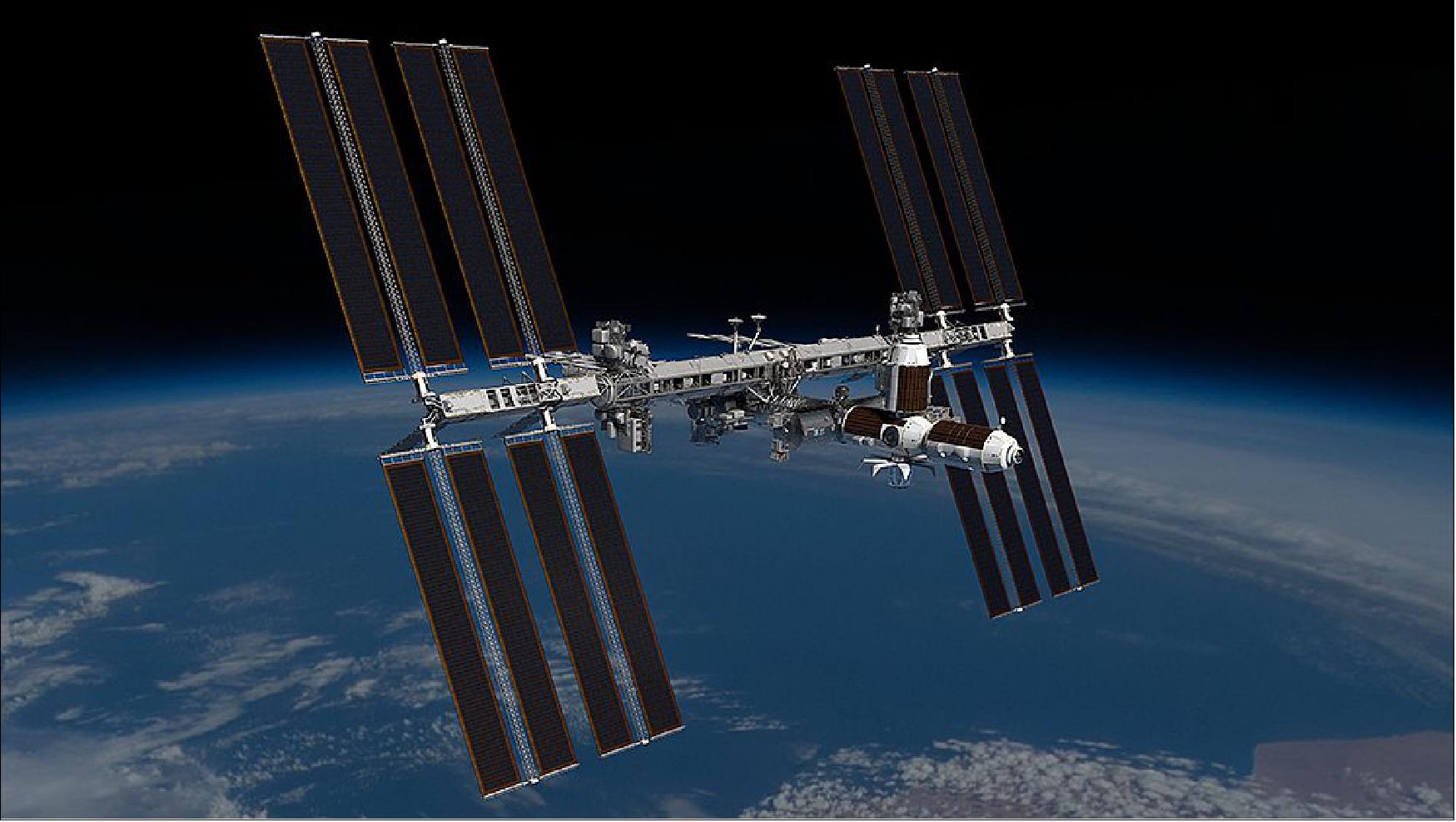
- Axiom is offering professional and private astronaut flights to the ISS at a rate of up to two per year, with the first set to launch in October 2021, while it develops the new station elements.
- Based on its past successful experience building modules for the International Space Station, Thales Alenia Space will be responsible for the design, development, assembly and test of the primary structure and the Micrometeoroid & Debris Protection System for the Axiom Node One (AxN1) and Habitation Module (AxH), the first two Axiom station elements to fly. Axiom will receive these elements at their facility in Houston for integration and outfitting of core systems and certification of flight prior to shipping to the launch facility.
• March 5, 2020: Axiom has signed a contract with SpaceX for a Crew Dragon flight which will transport a commander professionally trained by Axiom alongside three private astronauts to and from the International Space Station. The mission, set to launch as soon as the second half of 2021, will allow the crew to live aboard the ISS and experience at least eight days of microgravity and views of Earth that can only be fully appreciated in the large, venerable station. 29)
- “This history-making flight will represent a watershed moment in the march toward universal and routine access to space,” Axiom CEO Michael Suffredini said. “This will be just the first of many missions to ISS to be completely crewed and managed by Axiom Space – a first for a commercial entity. Procuring the transportation marks significant progress toward that goal, and we’re glad to be working with SpaceX in this effort.”
- This is the first of Axiom’s proposed “precursor missions” to the ISS envisioned under its Space Act Agreement (SAA) with NASA. Discussions with NASA are underway to establish additional enabling agreements for the private astronaut missions to the ISS.
- Axiom plans to offer professional and private astronaut flights to the ISS at a rate of up to two per year to align with flight opportunities as they are made available by NASA, while simultaneously constructing its own privately funded space station.
- “Since 2012, SpaceX has been delivering cargo to the International Space Station in partnership with NASA and later this year, we will fly NASA astronauts for the first time,” said SpaceX President and Chief Operating Officer Gwynne Shotwell. “Now, thanks to Axiom and their support from NASA, privately crewed missions will have unprecedented access to the space station, furthering the commercialization of space and helping usher in a new era of human exploration.”
- With its team’s vast experience in human spaceflight, Axiom serves as a one-stop shop overseeing all elements of its missions. In addition to contracting with SpaceX for a Crew Dragon vehicle to transport its crew to the ISS, Axiom’s turnkey service for the mission – two days in transit and at least eight days aboard the ISS – includes training, mission planning, hardware development, life support, medical support, crew provisions, hardware and safety certifications, on-orbit operations and overall mission management.
- NASA recently selected Axiom’s proposal to attach its space station modules to the ISS beginning in the second half of 2024, ultimately creating a new ‘Axiom Segment’ which will expand the station’s usable and habitable volume. When the ISS reaches its retirement date, the Axiom complex will detach and operate as a free-flying commercial space station.
- By serving the market for immediate access to space while building the future platform for a global user base, Axiom is leading the development and settlement of low Earth orbit now and into the future.
About Axiom Space
- Axiom Space was founded in 2016 with the aim of creating humanity’s home in space to ensure a prosperous future for everyone, everywhere. While building and launching the Axiom Segment of the International Space Station to one day form the world’s first commercial space station, Axiom provides access to the ISS today by conducting crewed missions for professional and private astronauts. More information about Axiom can be found at www.axiomspace.com.
Axiom is led by co-founder and President/CEO Michael Suffredini, who served as NASA’s International Space Station Program Manager from 2005 to 2015 and oversaw the Station’s transition from assembly to operation and commercial utilization. Co-founder and Executive Chairman Dr. Kam Ghaffarian founded Stinger Ghaffarian Technologies, which rose to become NASA’s second-largest engineering services contractor and the entity which trains NASA’s astronauts and operates the ISS.
The leadership team also includes world-class, specialized expertise in commercial utilization of microgravity, on-orbit operations, astronaut training, space financing, engineering, space system architecture/design/development, space medicine, marketing, and law.
While making access to Low Earth Orbit global during the remainder of ISS’ lifetime, Axiom is constructing the future platform that will serve as humanity’s permanently growing home, scientific and industrial complex in Low Earth Orbit (LEO) – the cornerstone of human activity in space. It is where all spacefaring countries’ astronauts will go, researchers will advance their science, manufacturers will innovate novel products, space exploration organizations will test their personnel and systems, and where tourists and advertisers will expand their philanthropic and consumer activities.
References
1) Stephanie Schierholz, Matthew Rydin, Gary Jordan, ”NASA Selects First Commercial Destination Module for International Space Station,” NASA Press Release 20-007, 27 January 2020, URL: https://www.nasa.gov/press-release/nasa-selects-first-commercial-destination-module-for-international-space-station
2) ”Axiom Station,” Axiom Space, 23 June 2020, URL: https://www.axiomspace.com/axiom-station
3) Jeff Foust, ”NASA selects Axiom Space to build commercial space station module,” Space News, 28 January 2020, URL: https://spacenews.com/nasa-selects-axiom-space-to-build-commercial-space-station-module/
4) ”Axiom Private Astronauts Headed to International Space Station,” NASA Press Release 22-033, 8 April 2022, URL: https://www.nasa.gov/press-release/axiom-private-astronauts-headed-to-international-space-station
5) Jeff Foust, ”SpaceX launches commercial mission to ISS,” SpaceNews, 8 April 2022, URL: https://spacenews.com/spacex-launches-commercial-mission-to-iss/
6) Mark Garcia, ”Four Ax-1 Astronauts Enter Station, Meet Expedition 67 Crew,” NASA Space Station, 9 April 9, 2022, URL: https://web.archive.org/web/20220516005554/https://blogs.nasa.gov/spacestation/2022/04/09/four-ax-1-astronauts-enter-station-meet-expedition-67-crew/
7) Gary Jordan, ”NASA, Axiom Space, SpaceX Wave Off Private Astronaut Mission Undocking,” NASA Space Station, 19 April 2022, URL: https://blogs.nasa.gov/spacestation/2022/04/19/nasa-axiom-space-spacex-wave-off-private-astronaut-mission-undocking/
8) Jeff Foust, ”Weather delays Ax-1 return,” SpaceNews, 20 April 2022, URL: https://spacenews.com/weather-delays-ax-1-return/
9) Jeff Foust, ”Ax-1 undocks from space station after extended stay,” SpaceNews, 24 April 2022, URL: https://spacenews.com/ax-1-undocks-from-space-station-after-extended-stay/
10) Jeff Foust, ”Crew Dragon splashes down to end Ax-1 private astronaut mission,” SpaceNews, 25 April 2022, URL: https://spacenews.com/crew-dragon-splashes-down-to-end-ax-1-private-astronaut-mission/
11) ”NASA Partners with Industry for New Spacewalking, Moonwalking Services,” NASA Press Release 22-055, 1 June 2022, URL: https://www.nasa.gov/press-release/nasa-partners-with-industry-for-new-spacewalking-moonwalking-services
12) ”Axiom Space and Italian Government Sign Historic MOU to Expand Commercial Utilization of Space,” PR Newswire, 25 May 2022, URL: https://www.prnewswire.com/news-releases/axiom-space-and-italian-government-sign-historic-mou-to-expand-commercial-utilization-of-space-301554926.html
13) ”Axiom Space and the Mohammed bin Rashid Space Center (MBRSC) Sign Agreement for Astronaut to Fly on the International Space Station in 2023,” PR Newswire, 29 April 2022, URL: https://tinyurl.com/4vju28c3
15) Stephanie Schierholz, Josh Finch, Gary Jordan, Beau Holder, ”NASA, Space Station Partners Approve First Axiom Mission Astronauts,” NASA Press Release 22-013, 2 February 2022, URL: https://www.nasa.gov/press-release/nasa-space-station-partners-approve-first-axiom-mission-astronauts
16) Josh Finch, Gary Jordan, ”NASA Selects Second Private Astronaut Mission to Space Station,” NASA Press Release, 13 December 2021, URL: https://www.nasa.gov/press-release/nasa-selects-second-private-astronaut-mission-to-space-station
17) Sandra Erwin, ”Saber Astronautics to work with Axiom to bring Australian astronauts to space station,” SpaceNews, 23 November 2021, URL: https://spacenews.com/saber-astronautics-to-work-with-axiom-to-bring-australian-astronauts-to-space-station/
18) Jeff Foust, ”Axiom Space outlines research plans for first ISS mission,” SpaceNews, 21 November 2021, URL: https://spacenews.com/axiom-space-outlines-research-plans-for-first-iss-mission/
19) ”Thales Alenia Space to provide the first two pressurized modules for Axiom Space Station,” Thales Group, 15 July 2021, URL: https://www.thalesgroup.com/en/worldwide/space/press_release/thales-alenia-space-provide-first-two-pressurized-modules-axiom-space
20) Jeff Foust: ”Axiom Space purchases three Crew Dragon missions,” SpaceNews, 3 June 2021, URL: https://spacenews.com/axiom-space-purchases-three-crew-dragon-missions/
21) Jeff Foust, ”Whitson to command second Axiom Space mission,” SpaceNews, 25 May 2021, URL: https://spacenews.com/whitson-to-command-second-axiom-space-mission/
22) Jeff Foust, ”NASA says demand for private ISS missions exceeds flight opportunities,” SpaceNews, 11 May 2021, URL: https://spacenews.com/nasa-says-demand-for-private-iss-missions-exceeds-flight-opportunities/
23) Stephanie Schierholz, Gary Jordan, Beau Holder, ”NASA, Axiom Agree to First Private Astronaut Mission on Space Station,” NASA Press Release 21-059, URL: https://www.nasa.gov/press-release/nasa-axiom-agree-to-first-private-astronaut-mission-on-space-station
24) Jeff Foust, ”Axiom Space raises $130 million,” SpaceNews, 16 February 2021, URL: https://spacenews.com/axiom-space-raises-130-million/
25) ”Axiom Space reveals historic first private crew to visit International Space Station,” Axiom Crew Press Release, 26 January 2021, URL: https://www.axiomspace.com/press-release/ax1-crew
26) Jeff Foust, ”Axiom Space finalizing first commercial ISS mission,” SpaceNews, 23 October 2020, URL: https://spacenews.com/axiom-space-finalizing-first-commercial-iss-mission/
27) Jeff Foust, ”NASA puts solicitation for commercial free-flyer station on hold,” SpaceNews, 27 August 2020, URL: https://spacenews.com/nasa-puts-solicitation-for-commercial-free-flyer-station-on-hold/
28) ”Thales Alenia Space will provide two key pressurized elements for Axiom Commercial Space Station,” Thales Group, 24 June 2020, URL: https://www.thalesgroup.com/en/worldwide/space/press_release/thales-alenia-space-will-provide-two-key-pressurized-elements-axiom
29) ”Axiom Space plans first-ever fully private human spaceflight mission to International Space Station,” Axiom Space News, 5 March 2020, URL: https://www.axiomspace.com/post/axiom-space-plans-first-ever-fully-private-human-spaceflight-mission-to-international-space-station
The information compiled and edited in this article was provided by Herbert J. Kramer from his documentation of: ”Observation of the Earth and Its Environment: Survey of Missions and Sensors” (Springer Verlag) as well as many other sources after the publication of the 4th edition in 2002. - Comments and corrections to this article are always welcome for further updates (eoportal@symbios.space).